Trout fishing season is here
JACOB LUCAS

 Nelson Marlborough Fish & Game
Nelson Marlborough Fish & Game
The much-anticipated trout fishing season is here. After what was one of the wettest winters for many in the top of the south, the October fishing season brings with it a wel come recreational opportu nity.
Many anglers, having gone into somewhat of a fishing hibernation over the winter months, eagerly await the first day in October. Rivers and lakes that have been closed to fishing, re-open, bringing the prospect of getting into na ture and a chance at catching trout that haven’t seen a lure for five months. After a hectic period of high rainfall in late

winter, the taps have eased off a bit, bringing with it sta ble river flows and warmer conditions – ideal for sight fishing and activating trout into feeding mode, so fishing should be great from day one. While most anglers seek sol itude in more remote waters that have been off limits for winter, the lower reaches of our rivers close to towns can also provide some really ex citing fishing during spring. Many of these waters are open all year, and some fantastic fly or lure fishing can be had.
If fishery enhancement is your thing, the Nelson Marlbor ough region carry out regular releases of (1kg+) rainbow trout regularly during the season. Last year, over 5000
takeable fish were released into Lake Argyle, the Branch/ Leatham, and the new fishing facility at Waimea Park. This year a similar number of fish will be released for the benefit of Fish & Game licence-hold ers, and we receive a huge amount of positive feedback from the recreational oppor tunity this provides, especial ly from families, beginners, and less mobile anglers.
Lakes Argyle and Brunner are distinctly different stillwa ter fisheries,but receive some of the highest fishing effort in their respective regions –and rightly so. Brunner is an amazing West Coast lake fish ery with a high population of









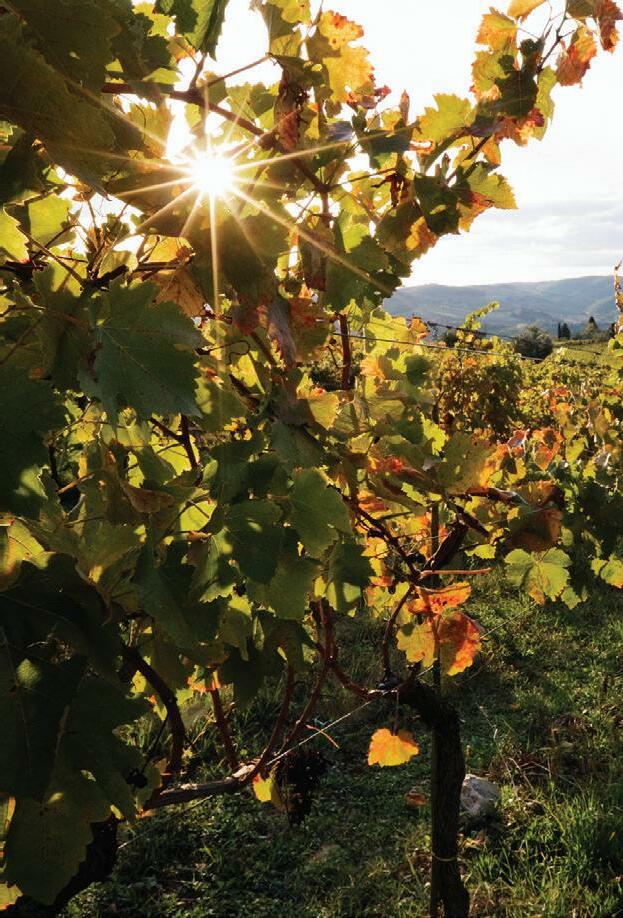


ON farM SErvicE A NEW SEASON BEGINS WITH THE RIGHT TOOLS! Rugged frame construction Cutting elements supported top and bottom for added strength Quality hydraulic system with electric control PRE-PRUNERS TOBY raNDaLL 027 233 9170 toby.randall@harcourts.co.nz www.tobyrandall.co.nz Team Toby Randall Top of the South rural “New ideas, Old school values!” 0800 541 8512 hogarthspreading.co.nz 0274 517 134 For all your Fertiliser, Lime & Seed Requirements • Mini Spreaders • 4x4 Flotation Spreaders Advanced GPS Guidance + Mapping CERTIFIED OrdersTaking NOW! LOCALLY OWNED AND OPERATED CIRCULATING TO 14,500 RURAL PROPERTIES IN MARLBOROUGH, TASMAN, NELSON AND WEST COAST OCTOBER 2022 TOP SOUTH MONTHLY Farming Est 2001 Blenheim PictonTapawera Murchison Reefton Nelson Wakefield Motueka Takaka Collingwood Kaikoura Greymouth Karamea
Scott Barnes (5) is stoked with his first trout at the Lake Argyle hydro facility, as is sister Ria. Photo: Supplied.
SEE PAGE 3
Farming



Note from the editor
BARBARA STUART EDITOR

What a month it’s been with so much happening on the global stage and even here at home.
The passing of Queen Elizabeth and the rumblings of those old men in Russia threatening nu clear war in the Ukraine all a reminder that peace is very pre cious and should not be taken for granted.
Meanwhile the first flush of spring is almost over here by the sea. The snowdrops and spring flowers are past their best. Lambs are docked and regular showers have kept the grass growing but for many in
the dairy sector especially in land its been a tough spring, they are still supplementing and milk production is back.


So what lies ahead from the coming season? Ocean and atmospheric conditions tell us that La Niña—the cool phase of the El Niño-South ern Oscillation (ENSO) climate pattern—current ly reigns in the tropical Pacific. It is becoming more likely there could be flooding in the north and drought in the south of Ao
tearoa this summer, a climate scientist says. New data from the US weather service shows the likelihood the La Niña weather system will linger for a third year has increased to 66 percent.

We are being warned this sum mer is shaping up to be a scorch er. The northern hemisphere June 2022 records saw the warmest temperatures over the world’s land areas – and re cord–breaking heatwaves have swept across the northern hem
Murchison Spring Flower Show
BARBARA STUART
The annual Murchison Flower Show Garden Club organisers decided to take a fresh approach this years event which was held at the end of September. They want ed to be more inclusive of the local community and encourage people to bring along a spring flower from their gar den. Organiser Marion Thomas reports it was a real success and has provided new ideas for the future.
Organiser Kylie Ser geant says the flower show is a whole com munity effort with en trants from the local area school and the kin dergarten children who entered sand saucers and pressed flowers. Entrants were displayed

to meet the official Daffodil Society cri teria with at least two blooms in each section and as many as ten for the more popular vari eties. There were also iris’s, hellebores, tulips and freesia’s on display. One of the sections was to decorate a wheel with seven entrants that were eye catching and hu
morous. One a bicycle with the rider crashing. This years event was a fund raiser for Murchi son Aged Care and the Nelson Hospice with Devonshire teas on sale, a barbecue run by the Youth Council and stall holders selling a range of products, honey, soaps, plants, cut flow ers and a raffle.
isphere, particularly continen tal Europe, the UK, China and parts of the US.

The first half of 2022 saw a dou ble dip La Niña, with cool con ditions returning to the tropical Pacific after returning to neutral conditions in the second half of 2021. This persistent La Niña contributed to temperatures being a bit lower than they oth erwise would be. Predictions from models for the remainder of the year mostly project con tinuing modest La Niña condi tions, with ENSO-neutral con ditions only expected by early 2023. Lets hope the prediction of neutral conditions makes for an easier farming season ahead.
Letter to the editor
Dear Ms, Tony Orman’s article about Sporting Hunters’ Outdoor Trust spokesman Laurie Collins and his concern about the central government be ing ‘off target’ with its firearm ‘reforms’ (‘TOSF’ SEP2022) are spot-on. What wasn’t mentioned was the firearm registry, the establishment for which will cost the taxpayer a million dollars a week, seems unlikely to be able to demonstrate proof of ownership, just as the recent news re ports about motor vehicle registration show that its doesn’t work there either.
If registration is supposed to be so effective for crime prevention and solution, why is it not working for the 30,000 or more registered motor vehicles reportedly stolen? Far small er numbers of firearms are report to be stolen than that (less than 2,000 annually).


And if registration as an exercise was effective, why wouldn’t the registration of cutting and stabbing instruments be considered? (After all, there is a lot more violence committed with cutting and stabbing instruments than with firearms).
Yours faithfully, Chaz Forsyth




Live Local. Shop Local. Love Local! Does your vehicle need some attention? We’ll make sure you’re good to go! Your friendly local for all your automotive needs including: • WOF’s (Cars, Caravans, Motorbikes, Trailers & Tractors) • Wheel Alignments & Tyres • All Vehicle Servicing & Repairs • Petrol, Diesel & LPG P: (03) 541 8121 F: (03) 541 9325 67 Whitby Road, Wakefield E: admin@wasl.co.nz W: www.wasl.co.nz67 Whitby Road, Wakefield P: 541 8121 www.wasl.co.nz Full Service Blade Sharpen Spark Plugs Lifestyle, Rural & Residential EXPERT ALTOGETHER BETTER WHAT IS THE VALUE OF YOUR PROPERTY? Request your FREE no obligation market appraisal. CALL FRITZ HORLEMANN 027 433 8208 I (03) 544 8860 fritz.horlemann@bayleys.co.nz VINING REALTY GROUP LIMITED BAYLEYS, LICENCED UNDER THE REA ACT 2008. R esidential / Rural / Lif es tyle Contact us 100% locally owned and operated 563 Main Road Stoke, Stoke, Nelson 03 548 5900 52 Scott Street, Blenheim 03 928 4121 Circulating to 14,500 rural properties in Nelson, Tasman, Marlborough and the West Coast every month.
TOP SOUTH MONTHLY News news@nmf.co.nz Advertising Sales Steve Page steve@nmf.co.nz Summa Donald summa@nmf.co.nz Raylene Wadsworth raylene@nmf.co.nz Accounts Queries accounts@topsouthmedia.co.nz Got something to buy, sell or promote? Contact us: sales@nmf.co.nz Farming TOP SOUTH MONTHLY 2 October 2022 News Farming TOP SOUTH MONTHLY
Mycoplasma Bovis has a long tail
At the beginning of the Mycoplasma Bovis out break farmers were warned the disease would have a long tail, this is proving to be the case.
Currently there are still three properties with the disease in the South Island.

Although the end is in sight farmers are asked to remain vigilant, especially when purchasing stock.

The advice from the Ministry of Primary In dustry is to remain alert.


With calving well underway many rural schools host calf clubs and shows will take place where calves and cattle are attending, it’s a timely re minder to make sure you keep your animals as safe as possible and minimise risk of infectious diseases.
The main way Mycoplasma Bovis is spread is by close contact between cattle. Pens are rec ommended as the best way to keep individual calves separated or tethered at least two metres apart.


Parading calves should be wearing halters to help reduce contact.



Wandering stock should also be treated as in fectious, isolate cattle immediately from your own stock.


Trout fishing season is here
FROM PAGE 1

wild brown trout, and is open all year. It has some great rivers entering into it too, providing exciting fish ing options when the new season opens. Lake Argyle, on the other hand, is a small man-made hydro lake in the Wairau Valley, and is one the region’s most popular plac es to fish for rainbow trout (mostly released by Fish &
Game and largely funded through Manawa Energy).






Success rates here are high, and fish here can be regular ly seen cruising the shallow sandy flats on the lake and are suckers for softbaits, or bait fishing tactics.
This year the start of the fishing season also coincides with school holidays creat ing a great opportunity to get the family amongst the early season excitement.
Wherever you may fish, it is well recognised that we have it pretty good in Aotearoa, and the West Coast and Nel son Marlborough regions are no exception. This year international anglers will be flocking back here to get a taste of the action after a few years away. Tight lines for those of you who are hit ting the rivers this season, and for any readers that are thinking about giving trout
fishing a go, or getting back into after a while, get in touch with your local Fish & Game office – they have heaps of great advice to get you sorted and boost your chance of success.

2021 2021 Date: 03/09/2020 No. of pages: 1 From: Kevin Quinn Phone: 022 639 2655 Size: 48mm x 86mm HILUX, HIACE AND EVERYTHING IN BETWEEN TOW BEHIND LOG SPLITTERS FREE DELIVERY to Nelson / Blenheim / Takaka / Westport / Greymouth Visit us at 109 Bolt Rd, Nelson 1.6m - 3.6m Optional Seed Spreader Top Quality PTO chippers Gravity or hydraulic roller feed 3.5”, 5”, 7” and 10” models CHIPPERS NEW PRODUCT 5 models available Made in NZ Powerful Kohler engines FROM $3,450+GST AERATORS NewsFarming TOP SOUTH MONTHLY October 2022 3
BARBARA STUART
Photo: Gary Ellis, unsplash.com
Stuart Smith’s winery bill up before parliament
A law change that will help streamline the process required for wineries to sell samples at the cellar door was recently drawn from the Member’s Bill Ballot.
MP for Kaikoura and National’s Viticulture spokesperson Stuart Smith says it’s good news. “The Sale and Supply of Alcohol


(Cellar Door Tasting) Amend ment Bill will plug an important gap in the old legislation so that winery cellar doors can now charge visitors for wine samples without having to secure a sep arate on-license and all the costs associated with that. While this may be a

small change, it will make a big difference to New Zea land’s wineries,” he said.



This Bill has been drawn at an opportune time as wineries have faced significant costs and reduced produc tion as a result of the pandemic.


The regulatory change will en

sure that they can provide cellar door services without the unnec essary extra red-tape.
New Zealand’s $2.5 billion wine industry has grown remarkably over the past 20 years, particu larly the cellar door tourism ex periences.
Now wine samples are a staple at cellar doors, but the old legisla tion hasn’t been updated to ac
commodate this.
“By tiding up the legislation and allowing wineries to charge for samples without obtaining an on-licence, it will encourage more cellar doors to open for the enjoyment of tourists and those wanting to taste New Zealand wines – a big boost for our small wineries in particular,” says Stu art Smith.
Frontline biosecurity ranks bolstered









Biosecurity New Zealand has welcomed 17 new quarantine of ficers to help protect Aotearoa’s borders from invasive pests and diseases.
Eleven officers graduated on Fri day after completing an intensive 10-week training programme. They will work at frontline bor der locations in Auckland to en sure international travellers and imported goods comply with New Zealand’s strict biosecurity rules. The other six new officers have joined Biosecurity New Zealand’s border teams in Wel lington, Queenstown and Dune din.
The graduates will bolster Bios ecurity New Zealand’s frontline ranks as international passenger traffic begins to gather pace fol lowing the reopening of borders, says Mike Inglis, Northern Re gional Commissioner, Biosecuri ty New Zealand.



He says Biosecurity New Zealand will have recruited nearly 60 new quarantine officers by the end of this year. There are plans to re cruit a further 20 Auckland offi cers in early 2023.

Of this year’s recruits, 38 will be based in Auckland. In the oth er regions, 11 new officers have been deployed to Wellington, Queenstown, Timaru and Dune din. Another 12 will be recruited,


including four for Christchurch.
“The recruitment drive puts us a strong position to respond to the increased demand at the border,” says Mike Inglis. Biosecurity New Zealand also

recently welcomed three new detector dog teams in Auckland and has introduced new teams in both Christchurch, Queenstown and Wellington.


“We will continue to introduce
new detector dogs as passenger volumes rise.”
Tiffany Wearing picked up the He Whaai Whakaaro Award for the top graduate at last week’s ceremony in Auckland.
Her previous role at a cargo facil ity gave her a taste for biosecuri ty. She is looking forward to put ting her new skills into practice at Auckland Airport, where she will be based for the next six months.

Farming TOP SOUTH MONTHLY SOUTH Farming NEW SEASON BEGINS WITH TOOLS! Ploughing Champs come to SeddonFarming NEW SEASON BEGINS WITHTHE RIGHTTOOLS!PRE-PRUNERS www.tobyrandall.co.nz Toby Randall “New vic TE interested entertained becoming Handling high pressure 100% locally owned and operated RAYLENE WADSWORTH raylene@waimeaweekly.co.nz Phone: 027 458 9115 • Based in the top of the South Island we are 100% locally owned and operated • With Barbara Stuart, editor with extensive on the ground knowledge and a growing team of journalists and relevant editorial content to support her. • Delivered free to 14,500 rural mailboxes every month, from Greymouth, Westport, Nelson / Tasman, Golden Bay, Marlborough, Marlborough Sounds and everywhere in between • 20+ years of speaking directly to a target market for customers and readers alike. Providing agri-contracting solutions to the Tasman region for over 30 years. Locally owned and operated. Contact us today to discuss how we can help you. 027 606 2767 or 541 8626 ladley.contracting@gmail.com 4 October 2022 News Farming TOP SOUTH MONTHLY
TONY
ORMAN
Stuart Smith
Tiffany Wearing (front second left) with the He Whaai Whakaaro Award for the top graduate Photo: Supplied.



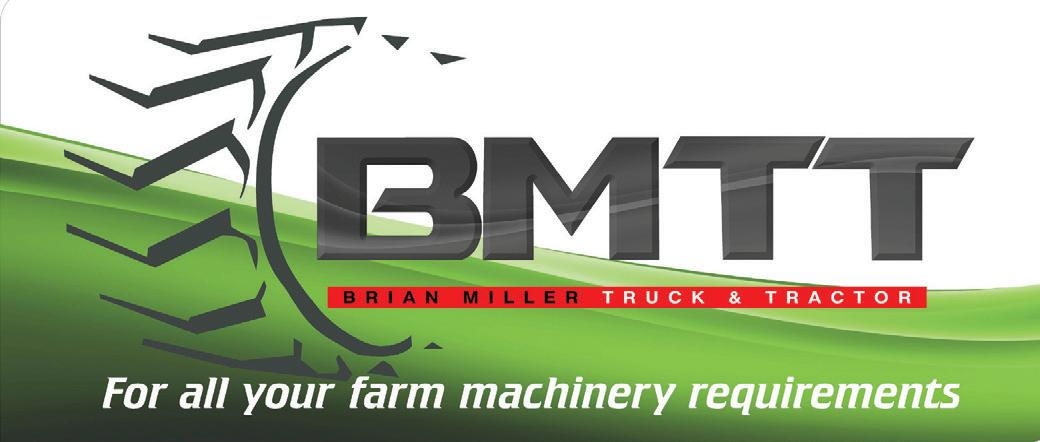








PH: 03 544 5723 Main Rd Appleby, Nelson 24 HOUR CALL OUT AVAILABLE Husqvana Ride On Mowers from $4,286 +GST Kioti CK3310 $31,980 +GST TRACTORS AND FARM MACHINERY Full service facility for all makes of tractor, baler, mower etc... Parts for all makes and models - All oils, lubricants, filters and wearing parts BMTT FINANCE AVAILABLE ON ALL NEW AND USED TRACTORS AND EQUIPMENT Krone Easy Cut R320 Mower $31,500 +GST JCB Digger 18Z $41,500 +GST Howards Slashers from $3,675 +GST Vicon PS403 Spreader $4,480 +GST Nelson Dealer for Sebco Fuel Tanks Fence Pro Post Drivers from $10,500 +GST Rata Implements from $1,730 +GST Sam Orchard Spreader $49,000 +GST Deutz Fahr Agrofarm 100 Rops with FEL $96,900 +GST AdvertFarming TOP SOUTH MONTHLY October 2022 5
Time to focus on the elephant of fossil fuels
Dr JACQUELINE ROWARTH
Heatwaves of unprecedented se verity have been experienced in the northern hemisphere. Wild fires have been reported across many countries. Floods have dominated the news in both hemispheres.
The focus on climate change mit igations is ramping up, yet the el ephant of fossil fuel keeps being ignored.
Energy contributes almost three-quarters of global gree nouse gas(GHG) emissions.
Approximately 5.8% of the con tribution comes from fugitive methane emissions leaks from fossil fuel extraction.
Co-incidently, animal agriculture also contributes 5.8% of global methan emissions. But whereas there are technologies for captur ing fugitive emissions technolo gies for altering ruminant physi ology in a practical way have not been released.
The United Nations 2021 meth ane report suggested that captur ing fugitive emissions would be relatively easy and that doing so would be low or neutral cost. So why isn’t it done?
Bizarrely, billions of dollars are given by governments globally
as subsidies to fossil fuel produc ers (to avoid unemployment and triggering inflation and a depres sion) and fossil fuel consumers (to keep prices affordable.)
An article of Dr Jocelyn Timper ley in Nature showed that more than 50 advanced and emerging economies representing about 90% of global fossil-fuel supplies, gave subsidies worth an average of US$555 billion each year from 2017-2019.
This ammount was described as “one of the biggest financial bar riers hampering the world’s shift to renewable energy sources”.
In NZ, part of the fuel tax was re moved in March when fuel prices escalated. The tax relief has now been extended to 2023 to help keep the cost of living down – at a cost of another half billion dol lars of revenue, and the release of more greenhouse gases as peo ple continue to travel in their normal way. Agricultural Pol icy Monitoring and Evaluation 2022 shows that the 54 countries monitored – included all OECD and EU economies, plus 11 key emerging economies- provided on average US$817b of support to agriculture each year of the 2019-21 period. This was a 13% increase from 2018-2020.
The report recommended phas ing out market price support and payments with strong potential to harm the environment and to distort markets and trade, and

reorientating investment to im prove the performance of the ag ricultural sector.


It also suggested implementing an effective pricing system for

agricultural GHG emissions to incentivise the transition to low emission agriculture. NZ operating without subsidies, is already ahead of the recom mendations.
To buy sandwich ham labelled “from New Zealand” cost ap proximately double that of the same brand with the label “pro duced from local and imported products.” Why? Because some of the systems used overseas to create cheap food are illegal here for animal welfare and other en vironmental reasons.
If the cost of production of food increased in New Zealand be cause of charges for greenhouse gases, consumers will be attract ed to imports from countries where food is cheaper to produce because the emissions associated are not taxed.
The global elephant of fossil fuel has a relatively quick fix in meth ane reduction. Ruminant methan will take longer. And food securi ty is a burning issue.
Dr Jacqueline Rowarth is an ad junct professor at Lincoln Univer sity. She is a farmer-elected direc tor of DairyNZ and Ravensdown, and a producer appointed member of Deer Industry NZ

Happier cows at Oaklands Milk
BARBARA STUART
Like me some of you may have noticed a large barn like struc ture has appeared at the Motu piko farm of Oakland’s Milk. On inquiry, its a Smart Shelter or Herd home with a compost ing base of wood chips de signed to make the cows more comfortable and happy.
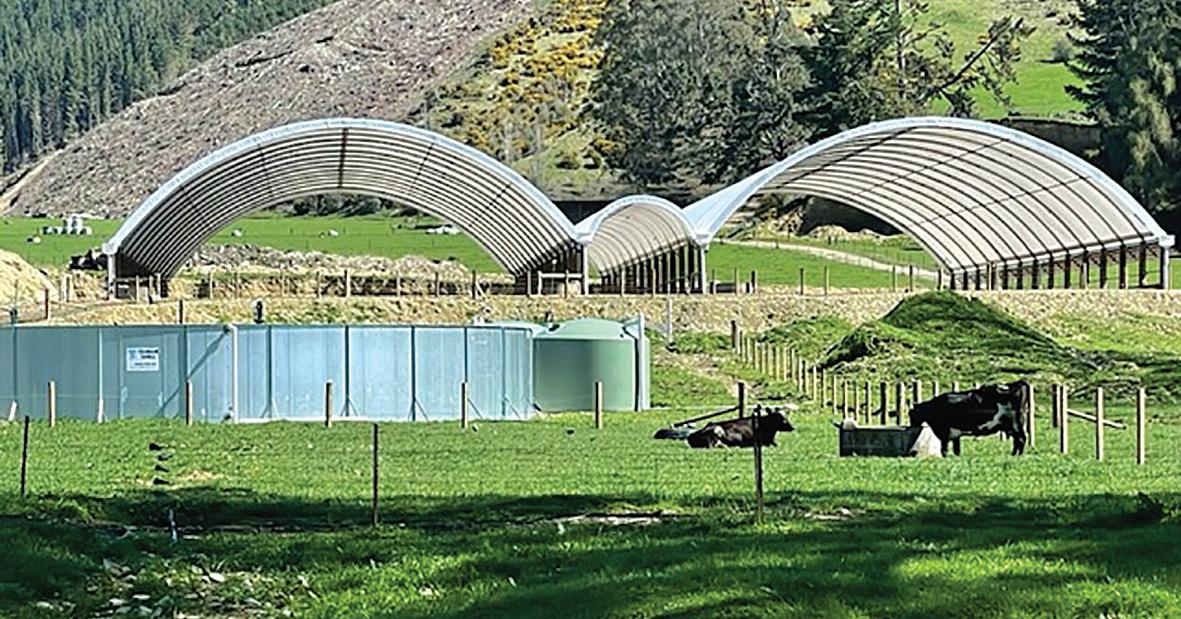
“We are slowly easing out of our Saxton Farm and shifting the herd to a colder winter environment by two degrees. This was going to impact on the cows. We need to milk 365 days of the year to supply our
customers, the idea of a herd home was an obvious choice to meet a number of outcomes, and we are not disappointed,”
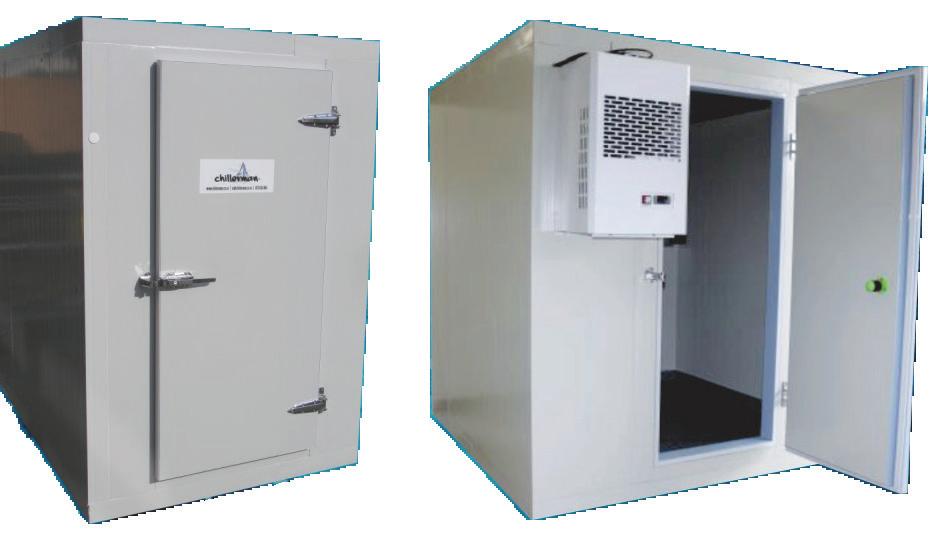
Julian Raine says.
The compositing floor is culti vated everyday to reduce com paction, the heat generated by the composting process keeps the cows warm in winter.
Its a great stand-off area in ex tremely wet weather, its also designed to capture and drain off liquid effluent which goes to a Tasman Tank to be re turned to land when soil mois ture permits.
The team have found there is

less feed waste and better pro duction. With predictions of a scorching hot summer ahead Motupiko is also two degrees hotter than Stoke. The cows will love the shade of a herd home then too. Its a win, win all round.
“The only negative impact is the hit at the bank! We’ve spent the thick end of a mil lion dollars and while there are a lot of compliance and animal welfare benefits it will take some time to recover from this level of investment and reduce debt,” says Julian with a chuck le.
For all land development, cultication, direct drilling, re-gassing, mulching, maize planting, apple tree planter, round & medium square hay and baleage production Mark: 021 454 000 Email: mark.carey@xtra.co.nz 28 Holdaway Rd, RD2 Upper Moutere Nelson 7175 New Service - Apple Tree Planter 6 October 2022 News Farming TOP SOUTH MONTHLY
The Motupiko Herd Home of Oaklands Milk houses 350 cows currently but has capacity for 500. Photo: Supplied.
Dr. Jacqueline Rowarth. Photo: Andrew Ritchie.



AdvertFarming TOP SOUTH MONTHLY October 2022 7
Meryn Whitehead wins 2022 Young Grower of the Year final
Meryn Whitehead, a 28-year-old supervisor at Vailima Orchards, has won the national title of 2022 Young Grower of the Year, held in Nelson.

“It is a real privilege to be named the winner of this year’s competition, espe cially given the impres sive talent on display,” says Meryn.
Meryn was one of six contestants that vied for the grand title in a series of practical and theoreti cal horticulture modules across two-days. The competition encourages young people to take up a career in horticulture as well as celebrating their success in the industry.
Despite being Meryn’s second year entering the competition, she says the experience has been nonetheless valuable.

“It has been an amaz
ing experience that has boosted my confidence, provided networking opportunities and de veloped my horticulture skills,” Meryn says.
“Taking part in this event and meeting other pas sionate growers has re affirmed my passion for this career and my love of growing.
“Horticulture is such a rewarding industry to be involved in, with so much potential and op portunities for all. I can’t wait for what the next chapter in this industry brings.”
HortNZ president, Barry O’Neil, says the calibre of this year’s contestants has been exceptional.

“It’s great to see such multi-talented young people emerging as the horticulture industry’s future leaders,” Barry
says. “Horticulture has had more than its fair share of challenges over the past couple of years, especially with labour supply, adverse climate events, shipping disrup tions, and the increasing cost and complexity of growing.

“These young people are well aware of these challenges and will be the generation who lead our industry through the next phase of this indus try’s development.
“They see the potential of our industry to nourish a local and internation al consumer base that is more conscious of how its food is grown and gets to the table. These young growers are also excited by the career opportu nities the New Zealand horticulture industry of fers them.”
8 October 2022 News Farming TOP SOUTH MONTHLY
Winner of the 2022 Young Grower of the Year national final, Meryn Whitehead. Photo: Supplied.
Boosted Molesworth Wilding Pine attack makes “immense” progress
lings still emerging.
Station’s invasion by wilding pines is being tackled with a determi nation and further energised by recent reinforcement. Since 2016 the anti-wilding pine programme has been boosted by central gov ernment investment overseen by MPI-Biosecurity NZ and deliv ered through the National Wild ing Conifer Control Programme.
“The NWCCP is implemented through regional councils and unitary authorities across the country who either directly deliv er programmes of work or team up with local partners,” says Marl borough District Council’s Biose curity Manager Jono Underwood.
“The boost has been significant particularly since budget 2000 when the ‘Jobs For Nature’ initia tive delivered $100 million over for years into the programme,” he says.
Collectively since 2016 this boost will add up to an additional $13.4 million into the Molesworth pro gramme.
As a result the last six years has
seen an immense amount of progress made in preventing wilding pines taking hold across large areas of lightly infested land while making inroads into his torical established problem areas says Jono.
Molesworth has a history span ning several decades of areas adjacent to Molesworth Station
being the source of conifer seeds. Back in the 1950s and through to the 1980s, the NZ Forest Service and initially the Marlborough Catchment Board planted pinus contorta in areas such as the Wye catchment on the mistaken belief that natural scree erosion could be eliminated.
Pinus Contorta has spread on to
both Molesworth and neighbour ing Muller Station.
From the south seedlings of both pinus conorta and Douglas Fir have invaded Molesworth. With in Molesworth stands of Pinus Sylvetris (Scots Pine) that were planted near Tarndale and have since been removed, have result ed in windblown seeds with seed
The size of the task to remove wilding pines from Molesworth led to a new delivery model in troduced three years ago. The Marlborough District Council engaged Boffa Miscall Ltd., to oversee delivery of a centralised programme of work. Backing the programme are Ngai Kuri as mana whenua, Pamu Farms, Department of Conservation, Biosecurity NZ, the South Marl borough Landscape Restoration Trust and the Marlborough Dis trict council.

Jono says while the last six years has seen immense progress, there is a potential danger that the gains made so far, could be diminished should adequate funding not be sustained from next year on wards for the National Wilding Conifer Control Programme as on Molesworth to reach its long term goals.
“Truly getting on top of serious wilding pine infestations like those at Molesworth takes much longer than we have experienced to date,” he says.

NewsFarming TOP SOUTH MONTHLY October 2022 9
TONY ORMAN
Workers stride out to combat the spread of wilding pines on Molesworth Station. Photo: Supplied.
Cheesemaking waste product potential gamechanger for diabetes sufferers

A New Zealand-based company researching alternative uses for a by-product from cheesemak ing has its sights on developing it into a remedy for people with type 2 diabetes.
WheyTech Bionics NZ is part nering with the Ministry for Primary Industries (MPI) on a two-year project that aims to de velop technology to process whey permeate as a sweetener product with anti-diabetic properties. Whey permeate is a by-product from the cheesemaking process.
“An existing patent from Germa ny shows the high levels of glu cose in whey can create a sugar with properties that are anti-di abetic,” says Steve Penno, MPI’s Director of Investment Pro grammes.

WheyTech Bionics has access to this patent. “Part of the project’s research and development pro cess will involve exploring the manufacturing and efficacy of an equivalent product made from New Zealand whey,” says Mr Penno.
Through the Sustainable Food and Fibre Futures fund MPI is
committing more than $111,000 to the $277,903 project. Whey Tech Bionics NZ’s chief executive officer Ben Van Rooy is excited about the potential of whey. “We need to stop overlooking whey, as it’s a marvellous product.
“We already have significant support from many quarters, in particular beverages companies keen to try alternative sugars.
Also, the chocolate and bakery sectors are interested in replacing what we know as normal sugars with whey-derived product.
“Currently there are no New Zea land made sweeteners on retail shelves. The imported sweeteners often have artificial ingredients added that don’t have any health benefits. This gap in the market presents a real opportunity.”
Milk producers from Canterbury, Hamilton, and Tauranga are pro viding raw product for the trials, which are being conducted by Plant & Food Research in Palm erston North and FoodSouth at the University of Canterbury.
“We’ve already managed to make a liquid syrup but we’re still working on the flavour profile,”
says Mr Van Rooy. “We’re also conducting research to ensure our product is stable and consis

tent.
“Our next challenge will be to turn the product into a stable
powder format that can be used in nutraceuticals. This will be technically tricky due to its stick iness but if we manage to achieve this, it’ll be a world first.”
Mr Van Rooy says the most valu able part of the project lies in the nutraceutical component of the product. “We’re hoping to eventually create a pharmaceu tical product that doctors will prescribe for type 2 diabetes. Of course, this will require extensive testing and clinical trials so will be a few years away – but this is my ultimate dream.”
Steve Penno says the opportunity to make good use of a common waste product is also a compel ling reason to support this proj ect.
“One of the strategic objectives of the Fit for a Better World govern ment and sector roadmap is the sustainable and profitable growth of value-added products from ex isting raw material.
“If this project is successful it will make a positive difference to our dairy industry, our environment, and potentially people with type 2 diabetes.”

Contact our friendly team today on 03 572 5173 Renwick or 03 544 5936 Richmond tractorrepairs.co.nz Spring is here, and it’s time to spring clean your equipment! • Mower, mulcher and trimmer parts • Oils and greases • Linkage parts and fittings • PTO parts and covers • And much more Come see the parts team at TRS for all your machine and implement service parts, including; 10 October 2022 News Farming TOP SOUTH MONTHLY
WheyTech scientists, working with whey. Photo: Supplied.
Farmers are one step closer to breeding more climate-friendly cows
New research has confirmed bulls’ genetics play a role in how much methane they emit, high lighting the potential for farmers to breed low methane-emitting cows in the future.
The welcome news comes fol lowing the first year of a research programme run by major New Zealand artificial breeding com panies LIC and CRV.
The research, funded by the New Zealand Agricultural Greenhouse Gas Research Centre (NZAGRC), measures methane emissions from the burps of young bulls set to father the next generation of New Zealand’s dairy cows. Results from year one, where the feed intake and methane emis sions from 281 bulls were mea sured, found there is genetic vari ation in the amount of methane emitted after accounting for the feed eaten by the bulls, with the lowest bulls emitting around 1520 per cent less methane than the average.
LIC chief scientist Richard Spel man says these results are a big step forward for the research.
“The amount of methane a bull
or cow produces directly relates to the amount of food it eatsgenerally speaking the more an animal eats, the more methane it will emit.
“But after accounting for differ ences in the bulls’ feed intake, we’re still seeing genetic variation in their methane emissions, prov ing genetics do play a role. He says the research has a slid ing scale from bulls that are low-methane emitters - less than 18g of methane per kg of dry matter eaten - to bulls that are on the higher end - more than 28g of methane per kg of dry matter eaten.
“This is the variation we were wanting to see and we’re excited to use it to our advantage.”

Although the research is in the early stages, Richard says the re sults show promise to help farm ers meet environmental challeng es.
“This methane research is a longterm project, but it has the poten tial to make a real difference to farmers in the future by provid ing another tool to reduce their farm emissions.”
A research programme run by artificial breeding companies LIC and CRV is one step closer to giving farmers the ability to breed low methane-emitting cows. Photo: File.
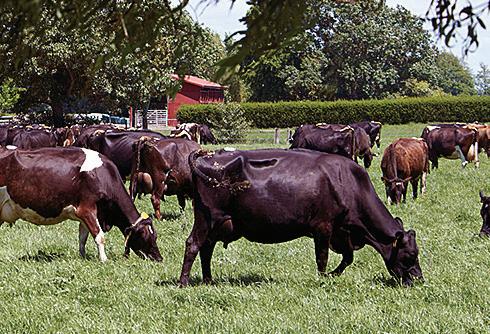
He says New Zealand farmers are striving to meet the challenge of being profitable and sustainable, and research like this will help en sure reducing a farm’s emissions doesn’t have to come at the cost of reducing its milk production.
CRV Grass-Fed genetics man ager, Peter van Elzakker, says it’s pleasing to see that the first-year results of the trial align with the company’s methane trial work with Wageningen University in the Netherlands.
“The findings in New Zealand are a significant step forward in our work to develop tools to help


Is it a wetland or not?
Wetlands as wet boggy parts of farms have become more complicated to understand and identify. Wetlands play an important role in our ecosys tems providing water filtration and a plethora of biodiversity values. Rare and threatened plants find refuge in many of our remnant wetlands, and they play host to native birds and reptiles. However, managing wetlands located within farms raises challenges around stock ex clusion and land drainage management. In recent years many councils began mapping wetlands in an effort to pro vide a clear rules framework, and to delineate clearly where rules apply. In many cases this work was undertaken remote ly using aerial photography and then verified on ground where either landowner per mitted access, or when rules triggered a need for resource consent. This usually resulted in reports by experts which clearly set out the wetland val ues and more clearly defined boundaries.
Rules to manage the use in and around wetlands typical ly include specific setbacks for structures, earthworks and stock to allow space for the wetland to thrive. In Marlbor ough for example, this was an
eight-meter setback and pro vided certainty to landowners that their actions would not impact upon the wetland val ues.
been considered by the envi ronment court in recent times where a wetland was consid ered as having a larger extent that previously mapped by council.
New Zealand dairy farmers re duce their emissions. They give all of us even more confidence ge netics can be part of the solution.”
Harry Clark, director of the NZAGRC, is equally pleased with these early results.
“Breeding represents a long-term and cumulative way that farm ers can reduce their greenhouse gas emissions. Low-methane se lection is now available to sheep breeders and the signs are posi tive that we might be able to de liver the same for the dairy sec tor,” he says.
Richard says the next step in the research is to see if the genetic variation responsible for methane emissions in growing young bulls is replicated in their daughters.
“This year, in partnership with Pāmu, we will breed from bulls that we’ve identified to be high or low methane emitters.
“After their daughters are born, we’ll measure their emissions as growing yearlings and during their first milking season, to en sure they’re representative of their fathers.
“This is where the rubber will re
ally hit the road in our aim to of fer farmers a low-methane breed ing solution.”
Pāmu chief executive Mark Leslie says Pāmu and Focus Genetics have an important role to play bridging the gap between science and commercialisation for the benefit of industry.
“We are pleased to see such pos itive results from the first year of this trial. It is vitally important that the agri-sector continues to move forward on emission re duction initiatives, and this trial is an exciting further step.
“This trial fits well alongside the dairy beef Progeny Trial at Re nown Farm and the Informing New Zealand Beef (INZB) Prog eny Trial at Kepler, which rely on our longstanding partnerships across industry, plus the progress we have made developing breed ing values for methane efficiency in our sheep programmes.” The second year of the research is now underway with methane emissions being measured from approximately 300 young bulls from LIC and CRV’s 2022 Sire Proving Scheme.
Services
New central government rules introduced in 2020 through the Fresh Water Policy State ment and associated Fresh water Environment Standard changes these provisions and introduced a 10 m setback to be adopted by authorities and to change rules around what activities can occur in and around wetlands.
Lockup
As National Environmental Standards are further up the hierarchy than district or re gional plan provisions under the RMA, the clear central government direction effec tively trumps local rules. This means that landowners who previously thought they knew exactly where wetlands trig gered rules, and what those rules were, may now have to look to the National Environ mental Standards for addition al rules.
Your
Furthermore, these provisions make it clear that wetlands might extend or be located outside of those previously mapped by district or region al councils. This can make it more challenging to under stand when the rules might apply, as landowners first need to work out if they are dealing with a wetland at all. This has
If you have a wetland on your property, or an area which might be considered as a nat ural wetland, it’s important to understand the extent of the wetland and what rules from both the National Environ mental Standard on Fresh water and regional or district plans might apply. Under standing these rules will help you to achieve a productive farm and be the guardian of your wetland, ensuring it pro vides flora and fauna benefits for generations to come.
Anna Bensemann, Senior Plan ner, Baseline Group
ough.
MARLBOROUGH
PLANNING | SURVEYING | ENGINEERING
Anna and the team are land development experts and can help with all your resource consent needs around the farm.
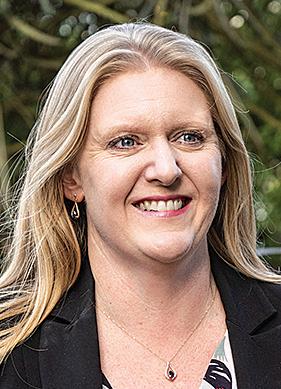

Get in touch about your next project, and with their experience and expert knowledge they’ll save you time and unnecessary cost in preparing your resource consent, giving it the best chance of being approved without delays.

SUBDIVISIONS AND BOUNDARY ADJUSTMENTS
WATER PERMITS
SEPTIC TANK DISCHARGES

HIGH QUALITY NEW ZEALAND MADE PROTECTIVE CLOTHING, BUILT FOR TOUGH CONDITIONS. Tel: 03 539 0022 Email: info@protectiveclothing.nz www.protectiveclothing.nz Factory Shop: 10A Forests Road, Nelson NewsFarming TOP SOUTH MONTHLY October 2022 11
ANNA BENSEMANN
Marlbor
Ph 03 578 7299 email: anna@blg.nz
Our primary logo is the full colour version shown at right. Alternative versions of the logo have been created (as shown on the following pages), but this version is always the preferred option. If space does not permit this logo in its full horizontal format, you may use the logo shown on the following page, or rotate this logo 90º and use it vertically (as shown below). This version is only to be used when absolutely necessary. Logo 5 BASELINE GROUP BRAND GUIDELINES 2018
core services are shown as a standardised lockup for consistency. This is available in landscape and portrait orientations.
SUPPORTING ELEMENTS
PLANNING SURVEYING ENGINEERING HORIZONTAL LOCKUP VERTICAL LOCKUP P. 03 578 7299 anna@blg.nz www.blg.nz
EARTHWORKS CONSENTS
OPINION: $100 million cost to another epic fail
BARBARA KURIDGER National Party Spokesperson for Agriculture

‘Putting the cart before the horse’ could have been written especially for this La bour government.
Time and time again over the past five years, they’ve made regulation announce ments and set implementation deadlines but failed to put into place any practical process or reasoning behind them.
A classic example is the fiasco by David Parker and his Ministry for the Envi
ronment, to create workable regulations for intensive winter grazing (IWG) on sloping farmland, along with the process to im plement them.
The intent of IWG regula tions is to protect freshwater resources, the welfare of our animals and our exporting credentials.
Much has been learned, par ticularly since the time of the many dairy farm conversions, about doing this well. Most farmers now
practice effective ways of reducing sedi ment runoff on their proper ties, but this can be more diffi cult in very wet weather.
The rules apply across New Zealand but are most applica ble in Southland, Otago and Canterbury due to the inten sity of winter grazing in those regions.


Created in conjunction with Damien O’Connor and his Ministry for Primary Indus tries, the IWG regulations were intro
duced inside the National Environment Stan dards for Freshwater 2020, as part of Essential Freshwater reforms.
But after a period of consultation, the unwork ability of what was presented quickly became apparent, forcing Minister Parker to delay their implementation for a year, in order to find a more workable solution.
Both the ministers, and their ministries, had put the cart before the horse.
During the delay, the government went into a consultation period with farmers, industry, iwi and hapū representatives, environmental groups and regional councils, in an effort to get them into a practical state.
Creating workable regulations for any indus try is critical. They must be fit for purpose and able to be applied through a good process.
So just why Labour insists on introducing reg ulations first, without talking to those affected and how they would work from the ground up, beggars belief.
In April, amendments to the IWG regula tions were finally introduced. While the de bate about their substance continues, they’re a marked improvement on the first version.
Under the regulations, farmers must have a certified freshwater farm plan (FWFP) for winter grazing on sloping land. If they don’t, they must obtain a regional council resource consent.
But therein lies the problem.
Two years after the regulations were first re leased, the environment ministry still hasn’t completed the framework, so farmers can cer tify their plans.
Officials have indicated they won’t be ready this year, yet the regulations are due to come into force in November.
Many thousands of farmers who need to plan next winter’s forage crops now, will have no al ternative but to apply for a resource consent. Forcing them to apply for resource consents at such short notice is unlikely to achieve any extra environmental gain.
Officials say as many as 10,000 resource con sents will be required, but industry estimates are higher. Each application is expected to cost up to $10,000.
That’s a $100 million cost if Minister Parker doesn’t rectify the situation in time. Moreover, regional councils wouldn’t cope with receiving 10,000+ applications. Consent ing teams will inevitably be swamped, mean ing the process will become a box- ticking ex ercise.
Farmers are already facing NZ’s highest infla tion rate in more than 30 years and sharply rising interest rates.
Adding a $100 million cost to NZ’s most pro ductive sector, because Minister Parker and his officials are ill-prepared to successfully im plement a policy, is an epic fail!
Got something to buy, sell or promote? Contact us: sales@nmf.co.nz Farming TOP SOUTH MONTHLY 12 October 2022 News Farming TOP SOUTH MONTHLY
READY FOR GRASS


BALE MADE
V6750 VARIABLE



A
BY PERFECTION
CHAMBER The McHale V6750 variable chamber round baler has been designed with the demands of today’s farmer and contractor in mind. High-Intake 2.1m pick-up • 15 knife heavy-duty chopper unit & feed rotor • Double drive system Auto Greasing • Net and bale density can be adjusted from the cab through the console The only mower with round discs. This gives better cutting and it leaves no pinch point for rocks to get caught. THE CUTTERBAR WITH ROUND DISCS The cutter-bar will swing backwards and up when hitting an obstacle and return to working position automatically (Instant reaction / non-stop). NON-STOP BREAK-BACK DEVICE The mower is lifted via the hydraulic cylinder – there is no need to activate the 3 point linkage of the tractor. EASY LIFT ON HEADLANDS The centre suspension provides an even weight distribution across the entire mowing width and a constant, faster and precise adaptation to ground contours. EVEN WEIGHT DISTRIBUTION FINANCE FROM 2.95%* FINANCE FROM 2.95%* Power Farming Marlborough Blenheim | 3535 SH 1, Riverlands | 03 573 7089 Trevor Youngman Sales 027 231 1186 Bryan Simpson Parts 027 362 1429 David Jeffery Sales 027 291 9576 Russell McGhie Service 027 365 1617 GET YOUR SEASON SORTED WITH THE KVERNELAND MOWER RANGE
? *Terms, conditions & normal lending criteria applies. While Stocks Last. AdvertFarming TOP SOUTH MONTHLY October 2022 13
Moutere
Sharyn
2023 NZ Dairy Industry Awards entries open
The 2023 New Zealand Dairy Industry Awards, open on 1st November and entrants are being asked to get prepared.
Organisers of the re gional programmes are gathering in Rotorua for the annual conference to learn how to deliver over 48 events and numerous judging days.
General Manager Robin Congdon says the confer ence is an opportunity for the many volunteers from around the country to come together after a busy winter season.
“The conference will be a busy few days, ensuring everyone knows what’s required to deliver the dynamic programme and bring them up to speed on this year’s changes made to the Share Farmer cate gory judging process,” he says.
“The Exec have reviewed extensive feedback on last year’s changes to the Dairy Manager and Dairy Train
ee categories, which was overwhelmingly positive. They are making changes to streamline the judging process and to align the Share Farmer category into the same format for this season, which will make the process less daunting and time-con suming for Share Farmer entrants to prepare for,” says Robin.
“The conference is also a chance for personal de velopment and for com mittee members to meet other regional committee members and share ideas and information, and to finalise their region al launch events, which provide an opportunity for prospective entrants to find out more informa tion about the Awards and which category people are eligible to enter.”
Robin says the regional launch events are typically a lot of fun and provide an opportunity to meet other potential entrants, organ
isers and sponsors and to learn about the awards from past entrants. “The functions are very social, with no charge, and are at a time that makes it easy for farmers to attend.”
More information on re gional committees and launch events are avail able at www.dairyindus tryawards.co.nz/regions, and on regional facebook pages.
Entries in the New Zea land Share Farmer of the Year, New Zealand Dairy Manager of the Year and New Zealand Dairy Trainee of the Year cat egories will be accepted online at www.dairyin dustryawards.co.nz from Monday 1 October 2022.
The New Zealand Dairy Industry Awards are sup ported by national spon sors DeLaval, Ecolab, Fed erated Farmers, Fonterra, Honda, LIC, Meridian and Ravensdown, along with partners DairyNZ and MediaWorks.

An extensive background in rural industry
Working in Real Estates rural and lifestyle sector is something of a dream role for Harcourts




Platinum Blue Nelson consult ant, Sharyn Miller.

Specialising in Lifestyle and Rural Real Estate in North Nel son, Rai Valley and Tasman, her extensive background in the sheep and agriculture industry spans 30 years and gives Sharyn a great understanding of what is important to her clients. Orig inally studying at Lincoln Uni versity, Sharyn went on to work as a wool buyer for a New Zea land wool exporting company for 14 years, purchasing wool on behalf of high-end Italian and Japanese spinning mills and liaising with farmers. This knowledge proved use ful when she went on to work for The New Zealand Merino Company as an area manager for 13 years working with her High-Country farming clients in Central Otago, Mackenzie

Country and then later in the greater Canterbury region. Involved in Rural Real Estate for five years, Sharyn says she found the transition to be an easy and natural one. “It is both an exciting and challeng ing industry to be a part of. I love being out in the country and dealing with all of the dif ferent aspects and variety of work that the rural industry in the Nelson/Tasman area have to offer. The people I meet and the very cool places I get to visit and bring to the market is a real highlight for me.” Sharyn is dedicated to achiev ing the best possible outcome for both clients and buyers alike.
Contact Sharyn directly on 021 377 930, or email: sharyn.mill er@harcourts.co.nz for more information.
“Whether you are buying or selling, I am here to help.”

Lower
0 Tasman View Road Land Bank or Farm (or both) Deadline Sale (Unless Sold Prior) Closes 1pm Thursday 20th October View harcourts.co.nz/NN25693 Platinum Blue Limited Licensed Agent REAA 2008 What an amazing opportunity this 39.66 Ha approx. block of land offers for the new owners. Located close to other Harley Road subdivisions just off the Coastal Highway and just out of Motueka. Zoned Rural 3 with views out to the ocean, the future possibilities are exciting. The current owners are running cattle and have spent many hours planting natives in the gully and around the two dams – what a beautiful asset. The land is undulating, comprising of gullies that drain into a wetland at the foot of the property, this wetland is protected in perpetuity.
Miller M 021 377 930 P 03 548 3034 sharyn.miller@harcourts.co.nz Rural 39.66Ha 227 Hardy St, Nelson Ph: 03 548 3034 Looking for the rural lifestyle? Sharyn Miller Rural Lifestyle Sales Consultant 021 377 930 sharyn.miller@harcourts.co.nz Licensed under the REAA 2008
Advt.
14 October 2022 News Farming TOP SOUTH MONTHLY
Book Review
“Bushline - A Memoir” by Robbie Burton, published by Potton and Burton, price $39.99.
TONY ORMAN
Robbie Burton, a partner in the Nelson pub lishing firm Potton and Burton, grew up in Nelson and from an early age, became ob sessed with the surrounding wilderness areas of nelson Lakes, Abel Tasman and Kahurangi National Parks. He became an environmental advocate with the now defunct Native Forests Action Council. The book is an engaging ac count of his life and his affinity with the wil derness landscapes plus his entrance into the world of publishing. Potton and Burton have established a high reputation for impeccably quality books.

Very much a personal memoir, the book is an absorbing read. Highly recommended.
Electricity price hikes hurting growers and consumers
TONY ORMAN
Fruit and vegetable growers are facing electricity price hikes with inevitable conse quence of high vegetable and fruit prices for consumers says Stuart Smith, MP for Kaikou ra.
“Fruit and vegetable growers are one example of an industry struggling with energy costs. After years of rapidly rising prices, many growers can’t af ford to heat their glasshouses.


That is a core reason why fruit and vegetable prices have in creased 15 per cent over the last year, and why Kiwis are forced to pay $15 per kilogram for tomatoes,” he said.
Industrial energy users pro vide New Zealanders with es sential items including fruits and vegetables, milk, building materials, basic household chemicals and others. When producers are hit with surging energy prices, added costs are passed on to the end consum
er “This means Kiwi families are paying more for essentials like fruit and vegetables,” he said.
Figures from the Ministry of Business, Innovation and Employment show that in dustrial electricity prices have increased by 63 per cent since Labour came to power.
“Compare that to the final five years under the last Nation al Government, when prices went up by just 0.01 per cent.”
Stuart Smith blamed Labour’s
ban on offshore oil and gas has forced New Zealand to boost coal imports, which recently had price hikes between 45 and 60 per cent. Instead of importing more coal which produces more emissions, New Zealand could have used indigenous natural gas to sup port a transition to a cleaner, greener economy.
He called on government to reverse the offshore oil and gas ban and use the fuel that is already in New Zealand.
NewsFarming TOP SOUTH MONTHLY October 2022 15
Protecting the low country through to the high country
DAMIEN O’CONNOR
and Agriculture Minister
The government made two for ward looking announcements last month that are focussed on our long-term economic security. One was protecting highly pro ductive land in the low country, while the other extends all the way to the high country where data shows we are winning the battle with wilding pines.
The new National Policy State ment on Highly Productive Land addresses the long known issue of losing our elite soils to urban sprawl.
The policy requires councils to identify, map and manage high ly productive land to ensure it’s available for growing vegetables, fruit and other primary produc tion, now and into the future.
It will put in place strong restric tions on the use of highly produc tive land for new rural lifestyle developments. This is a really im portant step.

The past 20 years has seen about 35,000 hectares of our highly productive land carved up for urban or rural residential devel opment, while 170,000 hectares of this land has been converted to larger lifestyle blocks. To put that
into perspective, Stewart Island is about 175,000 hectares. Since 2000, New Zealand’s population has grown from 3.8 to 5.0 million and along with that we’ve had pressure on housing, all of which has seen us losing the hinter lands of Christchurch, Hamilton, Auckland and more, to subdivi sion.
Of course, we still need to house people, but we also need to feed them. We just need to make sure subdivision and development is happening on the right land – not the best growing land.
I’m very much aware of these pressures around Tasman and Marlborough, and it’s great that this long-standing trend is being addressed.
Across the country it means fruit and vegetables will be grown close to where they’re consumed domestically, and the exporting capacity of our growing horticul ture sector can be preserved.
In case you didn’t know, this year horticulture provided $6.8 billion of export revenue for New Zea land.
On the topic of tackling wilding pines, I recently spoke at the 2022 Wilding Conifers Conference in Blenheim.
At the previous conference in 2020, I announced that we were
going to front-foot the control of wilding pines in a big way – ded icating $100 million to the effort over four years. With the COVID crisis raging at the time, we saw an opportunity to make this in vestment through the Jobs For Nature fund. The progress in two years is inspiring.
The National Wilding Conifer Control Programme has treated 1.4 million hectares in two years.
The result is 70 percent of known infestations have now been treat ed at least once.
For those who don’t know the
significance of this work, wilding pines are a major economic and biodiversity threat.
It was shown that if we did noth ing to control them it would cost the economy $5.3 billion over 50 years. And of course, the problem compounds as more trees drop seed.
Wildings consume farmland, but also threaten other parts of the economy such as hydro-power.

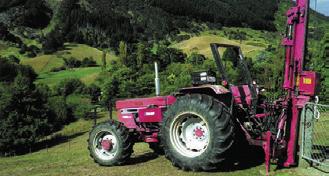
Depending on their density, these weeds can reduce the annual flow of catchments by up to 40 percent – depleting water levels in one of
the jewels of our sustainable fu ture: renewable hydroelectricity.


A 2018 Cost Benefit Analysis report showed that if the pro gramme focussed control efforts on 1.8 million hectares of the most vulnerable landscapes, this could protect 7.25 million hect ares from further infestation. Armed with that information we got on the job and I’m very pleased to report that the pro gramme is on track to exceed this target.
The remaining $35 million will be spent over the years three and four. The programme, and many others under their own steam, are doing an excellent job, and we need to keep working together to maintain all the ground we have gained so far – the battle against this urgent weed threat is far from won.

I thank all involved in the col lective battle on wilding pines. The storms have made it a tough spring across the Top of the South.
It was great to be able to get out on the motorbike and see the im pacts first-hand. As always, rural communities are so good at com ing together to support the worst affected.
I hope the coming season is a good one for you.
Your Portable Sawmilling Specialist Turn your trees into valuable building timber • Wire & Barbed Wire Fences • Rotary Slashing • Grass Topping • Gorse Spraying • Portable Sawmill • Horse Fences • Electric Fences • Boundary Fences COMPETITIVE RATES AND FREE QUOTES MIKE NICHOLLS CONTRACTING A/H 03 545 0093 or 027 847 9445 mikenicholls1970@hotmail.com www.mikenichollscontracing.co.nz 16 October 2022 News Farming TOP SOUTH MONTHLY
Biosecurity
Got something to buy, sell or promote? Contact us: sales@nmf.co.nz Farming TOP SOUTH MONTHLY
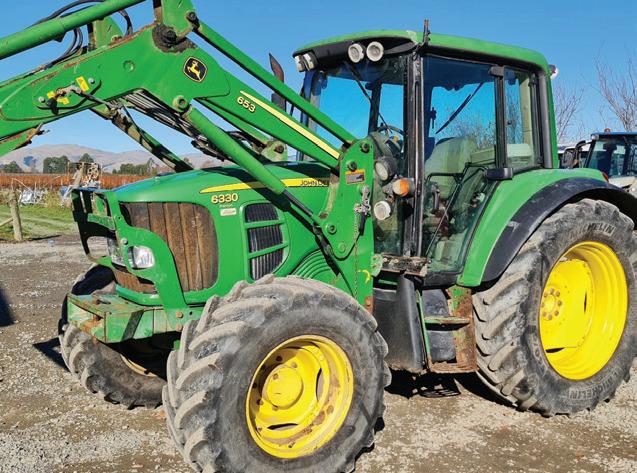








FARM MACHINERY & REPAIRS LTD Graham 021 228 3956 All prices plus GST Quality Used Tractors and Machinery • John Deere 1850 4x4 with very good loader, new clutch and other work $22,500 • Massey Ferguson 135 Power steering late model. Coming in • Massey Ferguson 4255 105HP stoll loader 4600hrs. In workshop • Iseki 2160 22hp hydro in tidy order - $5,750 • Massey Ferguson 188 2WD loader, wet brakes, tidy order $10,750 • Howard AR 70” Rotary Hoe • Rata vineyard cultivator crumbler range of sizes available • Dual wheels Snap/locks 38” 36” 34” 30” from - $2,200 • 11 tyne & 13 tyne grubbers from - $1,500 • Duncan 3m Maxitill very tidy - $2,000 • Rollex 6 metre folding roller, clod crusher rings coming in • Clough Contoura tidy order 14 feet - coming in • 9ft Cambridge roller - $1,800 • Trimax 1.8 Vineyard Mower, tidy order - $3,000 • Hydralada double in-row vine trimmer. Fully serviced with joy stick - coming in • Mole plough good order - $1,850 • Silvan G3 vineyard Sprayer good condition - $6,000 • Nobili VK135 mulcher - $3,500 • Silvan 600l herbicide sprayer electric controls - $5,000 • Fieldmaster M70 mower - $3,450 • Giltrap 2.1 vineyard side delivery mower - coming in • Farmguard 2.4m H-Duty Blade all hy control with land wheel - $8250 • Grader Blade 2.5 wide great order - $3500 • MF grader blade very good condition - $2500 • Nobilo vineyard mulcher VKD170 in excellent condition - $6000 Fieldmaster M60 Topping Mower. $3,200 No.3 Iseki 6500 and loader Uro hitch bucket good rubber 4x4 65 70hp good order $15,500 Massey Ferguson 6712, 120 HP. Current model excellent condition. Very good rubber. Self levelling loader 3 remotes 3500hrs. Hard to find with these hours. $92,000 1000L motorised spray unit 150 reel and gun. Never used. $6,750 Kubota 5030 hydrostatic very low hours factory cab remotes. Coming in. Daedong 80hp 4x4 Cab & Loader, very tidy recon motor - $35,000 Iseki 6000 4x4 tractor with cab new front tyres 60 hp good reliable tractor. John Deere 6330 premium 110 hp JD self levelling loader very good tyres fully serviced and in good condition. $55,000
Massey
Ferguson 5711SL 2900hrs, good rubber, excellent condition. Semi power shift 100 LPM hydraulics. Hard to find with low hours 110 HP. $88,500 AdvertFarming TOP SOUTH MONTHLY October 2022 17
It’s all on the app




Are you?
Heather Alexander, regional partner for Ospri. Photo: Supplied.
Communication key to good Ospri outcomes
BARBARA STUART
Heather Alexander has been working for Ospri, the non-profit that works with farmers to manage animal disease, for the past two years.
Recently, her area has been ex panded to include North Can terbury and Karamea. Heather says, the role is about advo cating farmer views and as pirations when managing the spread of tuberculosis (TB) in animals and communicat ing with other stakeholders.


A major part of my work is also supporting farmers with NAIT – finding ways to work their NAIT obligations in with their personal farming system.
Its an ongoing battle she says, as the threat of animal TB or some other bio-security in cursion is always lurking espe cially where there are vectors who silently spread the disease
into beef herds from the back blocks. Partnerships with the Department of Conservation and local councils are very im portant also.
NAIT – in the unlikely event of Foot and Mouth disease coming to NZ, is also a criti cal component for managing animal movement records.

Reaching as many farmers as possible during this time is key to protecting our herds and farming livelihoods. Heather’s grandparents were sheep farmers in Balcutha which gives her an interest in matters rural. Initially she trained as a large animal tech nician but then spent time in Ireland, dairy farming where she found the indoor systems, especially calving very fulfill ing. When she came home to NZ she was offered a role with Ministry for Primary Indus tries as a case manager for My
coplasma Bovis outbreak, be fore finally taking up the role with Ospri.
One of the things she hopes to do more of is personal farm visits meeting with farmers and connecting in with more groups, supporting farmer ed ucation. Heather says, good relationships with farming families who are feeling the devastation of a TB herd in cursion is especially import ant for ensuring they are able to reach positive future out comes.
Also adding support to man age their NAIT records and getting farmers to understand and manage what is expect ed of them plus adapt to the changes coming at them left right and centre.
For more information con tact Heather Alexander 0272358599 or heather.alex ander@ospri.co.nz
Scan here to download the app today
Local news
Sports Events Property Flights
Visit usat AgFest 18 October 2022 News Farming TOP SOUTH MONTHLY
A baton that you want to be passed 368 Tadmor-Baton Road, Tapawera
With the lifestyle dream becoming more and more just that, this productive river flat grazing property could turn that dream into a reality.
The Lockwood style home, with warm matai and redwood timbers offers 4 bedrooms, cosy log burner and a large deck that wraps around the sunny side of the house with terrific views.

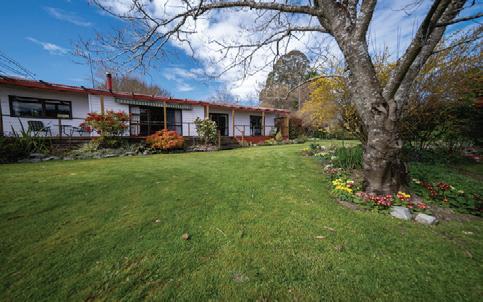
With a consent to irrigate, providing more options for now or into the future and excellent shedding, including a freestanding double garage/ workshop and large farm shed, plus smaller 3 bay stables this property certainly gets all the ticks.

A short walk across the paddocks to the Motueka river and a stones throw from Tapawera.
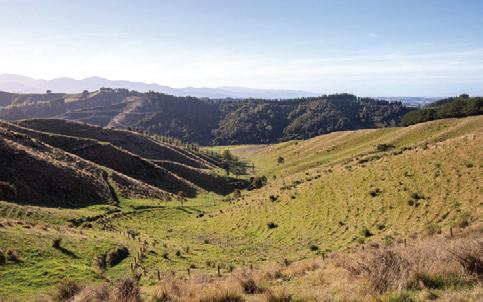
Farm Diversity is a Win!

0 Win Valley Road, Dovedale

135 Ha with a multitude of options… This private predominantly north facing secluded bare land block just outside of Dovedale offers approx. 55 Ha of easy rolling to steeper hill grazing, approximately 23 Ha of young Pinus Radiata with another 22 Ha ready to be planted on cut over, along with a large stand of established natives. Potential options open for future plantings and carbon farming.
Established access tracks make the running and maintenance of this property simple, alongside good fencing and cattle yards, 2 Dovedale units are available for stock water as well as other natural water and springs. A great hut at the highest point of the property makes the ideal spot to escape the world.
If this has your attention get in contact with the listing agents now for the full story.








D’Urville Island is certainly one of NZ’s special spots – so what better place to look at purchasing a fantastic 1.03HA property to create lasting memories with your family.


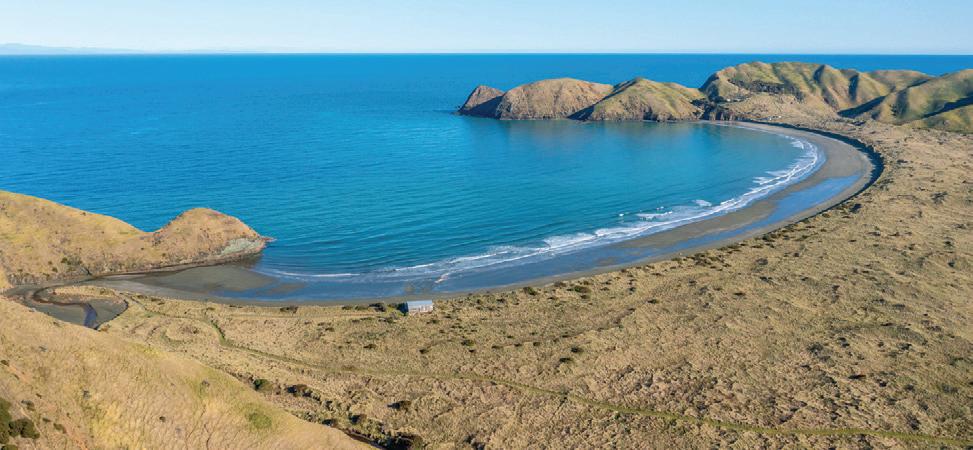


The bach itself is well appointed and enjoys all the comforts of home, without losing that real Kiwi bach feel. Moawhitu in Greville Harbour is a most desired location, with north facing beach, protected anchorage, stunning lake, recently planted in natives and DoC land that is “a playground” enjoyed by hunters, trampers and mountain bikers alike.
The remoteness of this beautiful spot is still easily accessible, either by boat, road or even fly, with the airstrip just 500m away. This is a once in a lifetime opportunity, so what do you say…?

Y o u r L o c a l R u r a l a n d L i f e s t y l e E x p e r t s Price on Application
Auction 4th November, 1pm ( Harcourts Rooms)
Let your dreams take flight Greville Harbour, D’Urville Island
Price on Application
AdvertFarming TOP SOUTH MONTHLY October 2022 19
In healthcare, local relationships are vital
The recent news that there were times when there is no emergency doctor cov er for the Buller District point to a practical exam ple of a new health system that is broken from its outset.
Until July this year we had twenty District Health Boards but Health New Zealand is now our new crown health agency. This current government decided that our health system had become too complicated for our small nation.

There was initial opti mism, but following our health system’s biggest shake-up in a very long time, the outcomes in this region are less than ac ceptable.
National’s Health spokes person Dr Shane Reti
recently returned to the Northland medical centre where he used to be a GP to find a clinic bulging at the seams, doctors work ing up to 70 hours a week and former colleagues left feeling devastated about their future.
I can understand the stress of not being able to get medical attention when needed. A recent situation with a close fam ily member demonstrated this: unable to see a doc tor, they waited five hours at A & E before giving up and going home and even tually, after precious days had passed, was diag nosed with a serious and life-threatening illness. It was not that long ago that I had a direct line to DHB Members: local people who were elected
by the communities they understood and served well. Now that DHBs have gone, all health decisions are made by this mega agency called Health NZ.
I will continue to lobby for local services, but that will be after I work out who or where I should approach in this huge organisation...
Trust me, it’s not easy. I have recently written to the Minister of Health on behalf of local people des perate for urgent help and so far no response at all. The stresses on our front line health professionals are at a point where pa tients are at risk.
Life and death stories are becoming all too common so what will make a dif ference here? – we could always send a road map to Health NZ to point
out the huge distances between hospitals but in more practical terms re laxing vaccine mandates will relieve some pressure for sure.
Unlocking the immi gration policies to allow more doctors and nurses into our country needs to happen right now to have any effect due to long lead times. Covid testing prior to starting shifts is a simple way to protect both patients and other staff and this would allow staff who have been stood down to return to work more quickly.
Our doctors, nurses and their patients need help now. I will continue to ask questions on local health issues until I receive the answers and assurances we all deserve.
fix
Faults?
fast,

time
“I really don’t want to see anyone in our community get hurt”
BARBARA STUART
Brian won’t say how long ago, but his uncle used to be the fire chief and asked Brian if he would like to join, Brian replied, “I might join – yeah.”
Nothing happened until one day the fire siren sounded, the fire truck stopped at my work on the way to the fire and un cle said, “Still want to join?
Jump in. so I did!” Brian says. Brian spent many years away from Murchison, returning recently to find that the bri gade could do with some help so he thought, “Yeah, it would be a good thing to do.”
The brigade had reasonable numbers but needed some di rection.
There were a lot of young members, so succession plan ning was a key to ensuring success, as well as refreshing my own skills to enable me to mentor younger members. Refreshing my skills took me to the National Training Cen tre where I completed the Sta tion Officer and Volunteer Ex ecutive officer courses which proved physically and mental
ly demanding.”
Fire and Emergency were very supportive and even though it was challenging, Brian says he really felt the support was there.
When asked about the differ ences he notices from when he joined to today Brian says that the equipment and support from Fire and Emergency is much better than it used to be.
Brian has held many roles within government agencies and executive positions which demanded a safety focus, safe ty has become a part of Brian’s life, he jokes that his family call him ‘safety Sara’ a handle that his son (who is a brigade member) now also has. When asked what his most challenging call has been, Bri an responds quickly “Friday night!”
He refers to a challenging and sad event where a home was destroyed by fire, “I guess I am critical of my own per formance and the fact that we were unable to save the house due to a lack of water supply, I felt quite helpless.”
I get the sense talking with
Brian that he has high expec tations of himself and sets his own bar very high, this is very fortunate for the community of Murchison and it’s brigade as it sets a standard for others to aspire to and improves the service delivery to the com munity.
The brigade has been suc cessful in recruiting more members and are planning for succession, they have people nearing the end of their fire service, so they are always looking for new members. The brigade is positive, active, and motivated, the comradery has improved massively, it’s an ex citing time for the Murchison Brigade. There is a real hon esty within the brigade Brian says, members have honest conversations in a non-threat ening way, “We are all wanting to learn and improve” What are your aspirations for Murchison Brian? “I want to reduce the amount of fires and calls – I really don’t want to see anyone in our community get hurt, but if it does happen, we respond to them in a pro fessional manner.”
Nelson: 78 Selwyn Place Ph: +64 3 548 8349 Richmond: 66 Oxford Street Ph: +64 3 543 9090 www.pittandmoore.co.nz Legal protection for your farm through the stages of life Make a plan to protect your farming and rural assets now and in the future. Inheritance/estate planning and wills Protecting assets Enduring powers of attorney Succession planning www.dieselperformancesolutions.co.nzCONTACT US TODAY Richard 027 608 9394 Canterbury & Upper South Island Tractor Adblue
We will
it
the first
TRACTORS • TRUCKS • HEADERS • UTES 20 October 2022 News Farming TOP SOUTH MONTHLY
National List MP Maureen Pugh explains why she believes “Wellington doesn’t know best.”
False prophet
The latest visitor knowing more about NZ than ourselves was self-described investigative journalist Monbiot, promoting plant foods to save the world. Using his guest status, he crit icised our diet as unethical, for trashing the planet, for using poisoning chemicals, and for our livestock farming driving the world to environmental collapse. He claimed our coun try had the greatest hunger for land whatever that means, and our pasture-fed meat caused most ecological cost, blaming us for global warming. Our penance was to remove all livestock from our hills and to stop all fertiliser to grow plant foods on the remaining 8% of cultivatable land. Apart from starving ourselves, destroying our economy would pay for our colonising sins.
Reverting our hill country pas ture land casually dismissed any disruption for the people who live and work there. And ignored re-establishment costs elsewhere for their jobs, hous es, schools, roads and other in frastructure. Replacing animal feed crops with human feed



crops and also expanding that area ignored the reality of phys ical contour, soils, climate and location, and the associated CO2 emissions from cropping, including harvesting. That needs new permanent crops adapted to every environment but plant breeders will struggle to not only develop species but specific varieties. Our pastures are already permanent, adapted to our conditions, and harvest ed cheaply by animals, instead of immigrants.
Despite urging us to get the sci ence right, he continued using unscientific and misleading statements and data to support
his claims. One example was proving his ideological theory by criticising false statements that few believed. That’s like challenging flat-earthers to prove gravity wobbles. Anoth er example was to blame us for increased global livestock since 2000 but ignoring the increase had largely been in poultry and pigs, and that global sheep and cattle numbers have reduced in the last two years. Like ours. However, his speculative phi losophy has used medieval sci ence to discover food alchemy based on a small UK vegetarian organic grower relying only on green manure crops, deep root

ing legumes and composted wood chips to grow vegetables. We know that depending on soil biology to ignore chemical aspects of soil fertility failed our pioneer farmers grow ing enough food, including in pre-European times. Now we use deep rooting legumes and pasture plants composted through grazing animals to effi ciently produce cheap complete protein food using free sunlight for energy.
But wait – there’s more. His fall back plant food solution needs expensive electricity from re newables, surplus after power ing universal electric vehicles, day-time air conditioning, night-time heating, and indus trial processes now using fos sil fuels. It uses little land and water to multiply micro-organ isms to produce incomplete protein flour. This capital-in tensive process using GE needs optimum temperature, pH, air flow and nutrient supply, and produces toxic compounds. To replace 340m tonnes of meat? He claimed to seek high-yield ing, low-input protein produc ers but enthusiastic ignorance blinded the NZ example in front of him.
Check out www.marlboroughshow.co.nz to fill out your entry form. New dates - Now on Saturday AND SUNDAY! • REDUCED gate charge • EQUESTRIAN is back • MORE FREE family friendly entertainment • MORE art craft sections to enter - open to all • Plus enjoy all the A&P Show favourtites It’s going to be a great weekend for the whole community! Get involved and be part of the fun! Saturday 5th & Sunday 6th November 2022 2022 Marlborough A&P Show REGISTRATIONS ARE NOW OPEN TO ENTER COMPETITION SECTIONS & TRADE SITES BIGGER & BETTER THAN EVER! NewsFarming TOP SOUTH MONTHLY October 2022 21 GARRICK BATTEN
Do you have some rural news? Contact us: 548 5900 Farming TOP SOUTH MONTHLY
Winter grazing rules remain unclear
Complying with a winter graz ing farm plan module through a Freshwater Farm Plan was to be the alternative to needing a re source consent for a winter graz ing crop.
But there needed to be some specificity in the regulations about what a farm plan would require, says Federated Farmers, board member, Colin Hurst. A start date for the regulations was delayed for a year in May 2021. Then delayed again to No vember 2022. But we learned in late July they still wouldn’t be ready.
As a balanced solution and given that flyovers and checks show a high level of good practice this season, sector leaders including Feds Presi dent Andrew Hoggard proposed to Environ ment Minister David Parker that farmers just use the existing winter grazing module alongside existing in dustry farm plans until the regulations can be developed. We still have no clarity on the way forward.
It’s deeply troubling the govern ment doesn’t seem to know how many farmers all this will impact. I was keen to get a han dle on this so worked with Feds staff to un dertake a survey of our members. Thanks for the hundreds of mem bers that filled in the survey.
Colin Hurst
Feds knows from our survey that it’s not just the bottom of the South Island. Around 90 per cent of respondents in Southland, Canterbury and Otago said they


planted winter forage crops but on top of this planting was also quite high in northern regions.
Over half of North Island respon dents south of the Bombay’s also planted forage crops with high numbers focused around the lower and central North island hill country.
Over half of all respondents said the winter grazing occurred on sloped land meaning a resource consent would be required.
The uncertainty is more than aggravating. All the risk is being put on farmers who are told on one hand councils won’t really
enforce the law, but on the oth er hand could still be prosecut ed if they find themselves on the wrong side of the council for any reason.
Unfortunately, delay remains the only tenable option. The pol icy was always a package deal with three options: comply with the new regulations; manage it through a Freshwater Farm Plan; or get a resource consent. Only a delay will allow the Fresh water Farm Plan regulations to be completed and for the farm plan option to be made available to farmers.
Loving life at Pakawau
Pakawau share Milkers Phil and Savannah Smith love the Golden Bay lifestyle. After milking herds of up to 1200 cows in Canterbury, Phil says the seasonal feed com plications of farming beside the sea are easier to manage than the staff required to milk that many cows.
The couple are enjoying milking 150 cows and while there’s always something to do he can manage the job and take time out with his family of six boys and one girl. Work life seems much easier.
“I just make sure I get the work done today so that tomorrow I can take a few hours out.” When
its cold and muddy inland, on the Pakawau spit regular rain has kept grass growing this winter. Phil is halfway through calving and likes to get milk in the vat early adapt ing to soil moisture because it will dry off earlier than other places.
“We only have six inches of top soil, underneath its sand therefore we need to run the farm operation around this fact, which means get ting as much milk in the vat while we can grow grass. Locally there is lots of support and advice through both PGG Wrightson and the Ru ral Service Centre who have won derful vets and technical advice available.”
Timeout for Phil has been playing Soccer. In Canterbury he played up to NZ de velopment lev
came first in the Charity Games raising $14,000 toward the Spe cial Olympics team drawn from the area. This season the Shield Maidens play their second annual charity game and raised $17,000 playing against the Richmond FC Bogans. “The team is inspiration al,” says Phil.

el
until injury stopped him play ing. Now he coaches Golden Bay Women’s Soccer and likes to raise awareness of the women’s game which has been badly neglected in the past. The Golden Bay Club’s, vision is to; “Give back to the community,” He says since Covid
struck and vaccinations could have caused division, being in volved with the local soccer, foot ball club has helped to keep the soccer community connected and socialising. “We all have opinions and leave it there.”
Last year the Shield Maiden’s team
RURAL SUPPLIES

Golden Bay Football Club has eleven travelling teams which in cludes two men’s teams and nine non travelling teams catering for all ages. The teams travel as far as Marlborough and have pools of eight around Motueka, Nelson and Tasman. Phil says the Golden Bay team culture is very support ive and strong which bodes well for the future of young players looking for a future pathway in the game further afield.

• Rope & Twine • Netting • Chain • Shackles • Hooks and Blocks • Rigging Services • Wire Ropes - Lifting - Crane - Irrigation - Strops - Post Driver - Stainless Ph 03 548 7942 www.hampidjan.co.nz info@hampidjan.co.nz 82 Vickerman Street Port Nelson Marlborough Des McMillan 027 547 8717 Cnr Grove Rd and Farmar Street, Blenheim Motueka / Nelson James Marshall 027 706 5610 88 High Street, Motueka
22 October 2022 News Farming TOP SOUTH MONTHLY
BARBARA
STUART
The Golden Bay Shield Maidens and Richmond FC Bogans. Photo: Supplied.
Accelerating
The Complete Lifestyle Package
minutes
sheltered
all the wish list boxes. The five-bedroom residence, set amongst
residence offers multiple living areas, open plan

Marlborough summer. Generous bedrooms including a spacious
ideal for teenagers or extended family. The 14.4m x 9m (129m²)
additional side door allowing for direct vehicle paddock access. Ideal
fenced paddocks, ideal for grazing with the
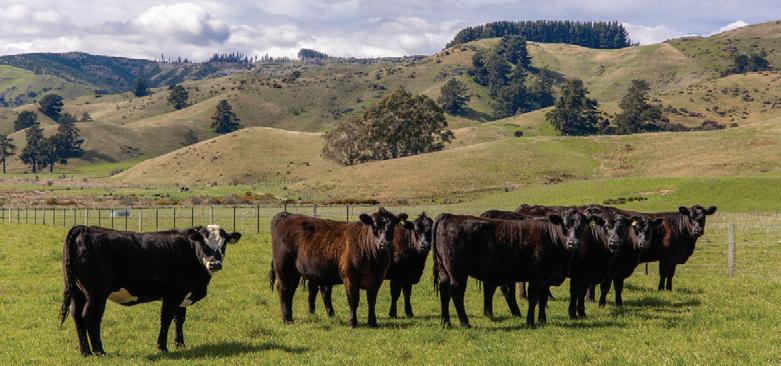




River.
opportunity to secure a seldom
success. colliers.co.nz
For Sale by Deadline Sale closing Thursday 13 October 2022 at 2pm (unless sold prior) Located just
from Blenheim CBD this seldom available 1.8ha appealing lifestyle property is sure to tick
private
grounds in desirable Lower Wairau with an array of bird life residing in the well-established, easy-care grounds. The
kitchen/dining, outdoor entertaining and BBQ area complete with in-ground pool, a perfect combination for the
master with walk in robe and ensuite with double shower. A separate standalone sleepout with toilet and shower is
secure shed is sure to excite and offers endless possibilities. Concrete floor and power, 3 x 3m doors plus an
for the caravan, motorhome and boat or tradesman work from home storage. Additional double garage with attached workshop. Two
productive fertile soils allowing for a variety of uses. White baiting, kayaking, and fishing at your doorstep with easy access to the Opaoa
Your
available property within close proximity to Blenheim CBD offering the complete lifestyle package and more. Marlborough Rural Realty Limited T/A Colliers. Licensed REAA 2008 For Sale colliers.co.nz/p-NZL67020577 Andy Poswillo 027 420 4202 andy.poswillo@colliers.com516 Dillons Point Road, Riverlands, Marlborough Farming, Carbon and Forestry For Sale by Deadline Sale closing Wednesday 26 October 2022 at 2pm (unless sold prior) Marlborough Rural Realty Limited T/A Colliers. Licensed REAA 2008colliers.co.nz/p-NZL67020714 Andy Poswillo 027 420 4202 andy.poswillo@colliers.com3213 State Highway 63, Wairau Valley, Marlborough 231 hectares held in three separate titles offering multiple purchasing options • Located 5km west of the Wairau Valley Township and 42km from Blenheim • Granted consent for 134ha exotic forestry establishment plus additional land for other species allowing for registration in the Emission Trading Scheme (subject to MPI approval) • Majority of the property is 200-390 MASL with well established forestry on the back boundary • Well tracked for ease of access, supported by a two-stand wool shed, sheep yards and cattle yards • Good balance of flats and easy down country currently running sheep and cattle. Approx 18ha of productive flats at the front allow for intensive grazing or diversification For Sale AdvertFarming TOP SOUTH MONTHLY October 2022 23
Questions over ban on cattle exports
TONY ORMAN
A future National government will review government’s recent law change banning live cattle exports, says National’s Animal Welfare spokesperson Nicola Grigg.
Despite National’s opposition,
parliament passed the Animal Welfare Amendment Bill into law, banning the export of live animals by sea from April next year.
“As New Zealanders grapple with a cost of living crisis made worse by the Labour government, to day’s decision signals more eco
nomic pain for farmers and con sumers said Nicola Grigg.


An Infometrics Economic Impact Report says this ban will reduce New Zealand’s gross domestic product by $472 million and cost export cattle breeders between $49,000 and $116,000 per farm, every year.
FLOOD REPAIRS
work with many Engineering,
and
Check out our huge range of products





to
Fittings, Poly Pipe fittings



Water
and Repair
PTO shafts and Bearings to Link Pins, Top Links and a huge range of hardware and accessories.

Plus much more at fair prices and quick efficient freight.



The website is designed to make it easy for you to select the right products, find a solution for your requirements and to make further ongoing transactions easy with smooth ordering and invoice processing. Order online, pop in or phone us.
Nicola Grigg said the Labour government failed to carry out its own robust economic anal ysis and ignored the proposed amendments the National Party put forward.
“Rather than an outright ban on live exports, the government should legislate for a ‘gold stan
dard’ programme that would set world-leading compliance standards like built-for-purpose ships, maximum stocking densi ties, vet and stock handler train ing, more robust reporting, ex porter licensing and an importer quality assurance programme,” she said.
Show time for sheep
MATT BROWN
Fewer sheep in the region, at least compared to the good old days, doesn’t mean easier com petition.
Close to 40 sheep, from Cor ridales to Suffolks, are expect ed to go toe-to-toe in the sheep section at the upcoming Marl borough A&P Show.
A&P Show sheep section or ganiser Chris Bowron, a sheep and beef farmer his whole life, says most breeds in Marlbor ough are still fairly strong, al beit now up the Awatere. But the profit-driven move to grapes has hurt Marlborough’s stud stock.
“The farming on the flat used to be sheep fattening, cropping and probably market gardens. “Virtually all of it has been pushed aside because of the wine industry. There was varia tion, before. The effect has been about an 80% reduction in the entries of the sheep section.”
He says there are a few hardy sheep farmers sticking it out in central Marlborough, as well as a few new, small-scale meat breed studs. But the competi tion is still expected to be tight.


“It’s advertising for your stud. “I’ve always been a commer cial farmer. You buy the breed,” Chris says.
A new judging section, for
commercial farmers, will see whole flocks judged. Judging the product, Chris says, instead of the stud.
Different breed classes will be looked over by independent judges and marked against spe cific criteria at Blenheim’s A&P Park sheep shed in November.
Wool types, such as merinos of course, as well as corridales and romney are expected while Chris says he hopes to see some new meat types in this year’s competition.
“We’re hoping the meat breed section of the show has some new breeders this year,” he says.
“A Hampshire stud started re cently, too, which isn’t com mon in New Zealand.”
Chris hopes bringing the coun tryside to town in November will “let the people in town know the countryside is still there.”
One of the Marlborough A&P
Show organising committee for about a decade, Chris says the show is a part of history.
“The committee is always working hard to keep it going and keep interest up,” he says. He says besides the formal judging, there will also be a well-supported fleece com petition and the ever-popular Gift Sheep competition with some amazing prizes donated by generous supporting busi nesses.
This year’s A&P is the region’s 149th show, and has for the first time in it’s long history it has changed days. The show will take place on Saturday and Sunday this year – instead of the traditional Friday and Sat urday.

Chris says there are only two shows missed in history – one during the war and one in the first year of the Covid pandem ic.

time! Exciting range of amusement rides for young and old. 32 King Edward St, Mouteka 03 528 9065 www.motfarm.co.nz Come and see us at our stand at the AgFest Greymouth 14-15 October Ag Fest Greymouth 14 - 15 October 2022 24 October 2022 News Farming TOP SOUTH MONTHLY
A&P Show sheep section organiser Chris Bowron. Photo: Matt Brown.
SUPPLY POINT WORKING WITH YOU THE FARMERS FRIEND Always, FAIR PRICES, GREAT SERVICE, FAST FREIGHT Email: online@supplypoint.co.nz 10 Henley Street, Westport. Phone 0508 348 846 Mon-Fri 7:00am - 5:00pm | Sat-Sun: Closed www.supplypoint.co.nz Our Aim is to supply proven, quality products with prompt delivery to make it easy for you and your project. We
Farming, Trade and Contracting Clients around NZ
look forward to continuing this trust through 2022.
from Culverts and
tanks,
PVC
to Valves
Couplings.,
- offering further discount to assist with damage
WEST COAST
Jackson Bay road could be abandoned - Westland mayor
BRENDON McMAHON Local Democracy Reporter

The special purpose road to Jack son Bay could be abandoned if Waka Kotahi NZ Transport Agency tries to devolve it to the Westland District Council, retir ing mayor Bruce Smith says. Westland had been resolute that it would not take it on, Smith said.
“I accept the fact NZTA have a shrinking budget, but they’re go ing to be stuck with it I’m afraid,” Smith said on Friday.
“If I was sitting around the table: We don’t want it, we’re just not in terested. One of the options we’d be left with is, just shut the road.”
In 2018, Waka Kotahi signalled a plan to phase out the special purpose road category (SPR) by 2024. The roads to Karamea and Jackson Bay are both currently funded as SPRs via the agency to the councils, which carry out the maintenance.
But a new model without SPR
status was still not clear and was
“forced on to us”, Buller mayor Ja mie Cleine said on Friday.
“At the moment, the discussion lines are open ... it’s been simmer ing away forever.”
Cleine and West Coast-Tasman MP Damien O’Connor wrote to Waka Kotahi about the situation earlier this year.
He raised the tone of their re sponse last week at the West Coast Regional Transport Com mittee meeting.
“There was some inference that Buller District Council were tak ing carriage of that [SPR] infra structure project,” Cleine said at the time. “That wasn’t Buller Dis trict Council’s understanding.”
Waka Kotahi regional relation ships director James Caygill agreed that the future of the Jackson Bay and Karamea roads needed “resolution”, but did not specify further.
“The SPRs at both ends of the [region] are very much on my ra dar” was all he said.
Unstable slip at the Seven Sisters on the Karamea Special Purpose Road, following the red category storm which hit Buller.

Photo: Supplied.
However, Smith said afterwards the change posed a “stark” pros pect for the future of Jackson Bay road.
“My position is the same as our full council has been for quite a long time: the ratepayers of West land cannot take over the mainte nance of that road.”
The road needed major invest ment to even be of an “acceptable standard”, with the swampy sec tion from Haast to the Arawhata River bridge particularly bad.
“The road is of a very poor qual ity. It’s well below an acceptable
standard.”
Smith said the pioneering cordu roy method of felling bush, laying down the timber and then form ing the road base over the top of the laid logs was the trouble. Over time, the logs rotted away and, exacerbated by heavier ve hicles, caused the road to slump.
“Unfortunately, it’s not some thing we can afford [to fix].”
Smith said the Karamea Bluff situation was a lot worse and he sympathised with the Buller council.

Cleine said he raised the matter at last week’s meeting because Waka Kotahi seemed to imply it was not running the new SPR process but was relying on the Buller Dis trict Council.
“We understood it was the oppo site way around... they were run ning it. We’re not working a plan because we think it’s their plan to work on.”

Buller wanted the status quo.
The council was currently fully funded by the agency to maintain

the road.
The signalled change in 2018 that SPRs would end in 2024 had been “a red flag” for the council, he said.
It arrived in the midst of a $900,000 repair on the road fol lowing a major slip in 2018.
“At the end of the day, we’re still holding the position: you can call it whatever you like, as long as you pay for it.
As it was, the Karamea road was “very problematic” to keep open. Again, the historic corduroy road continued to cause issues and the weather impacts were major. The “major” February storm repair job had yet to be resolved.
“The repairs up there are expen sive because of the terrain and the old school construction methods of the day,” Cleine said.
West CoastFarming TOP SOUTH MONTHLY October 2022 25
Spring Optimism in Golden Bay
BARBARA STUART
After a long wet winter and an other tough spring which in cluded the August storm event, Golden Bay Dairy farmers re main optimistic, says Jeff Ri orden, general manager of the Rural Service Centre.

The flood was bad but not as bad as it could have been. It affected side streams more and of course road access for a number of Collingwood farmers who were
unable have their milk picked up.
There was also an increase in metabolic problems due to a lack of magnesium all flowing from the wet conditions, cow body scores were back with farmers busy coping with calving. Overall production was back as a flow on effect of the tough spring but there is signs of im provement now with grass growth coming away again.
There are no supplements being
made yet and farmers are begin ning to gear up for mating. Be cause the payout is holding up and there is expected retrospec tive payments coming in from last season farmer optimism is good, says Jeff.
The Rural Service Centre and LIC held a pie day for farmers in both Collingwood and Takaka, where they get of farm to catch up with other farmers over a pie lunch at the end of September which was well attended.
Nelson Federated Farmers September 2022 report

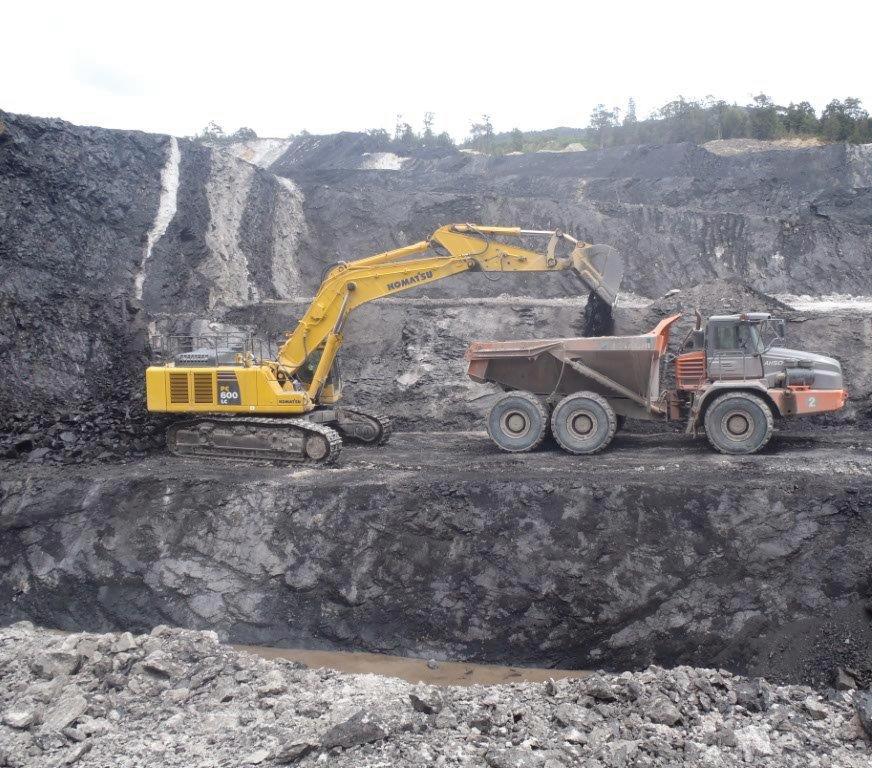
The enthusiasm and organisa tional thought and skills from Provincial support person El oise Martyn are benefiting not only FF members but the whole rural community. Like the sol id fortnight helping any farmers adversely affected by the earlier Golden Bay, Nelson and Marl borough flood events. That alone is worth supporting the organisa tion. For the future, in conjunc tion with various involvements from Waimea Rural Connec tions, Rural Support Trust, Rural Women, Findex and FMG, there are opportunities to facilitate farmers’ life off the farm at the Brightwater Scout Den in Char lotte Lane with CommuniTEA 1-3pm on 7 October, 4 Novem
ber, 2 December for a cup of tea and a chat. Plus the AGculture free meals and as much talk as there is time for from 6 pm on 12 October, 16 November and 7 December. Then there is the clay shooting event on 6 November delayed by COVID and the endof-year BBQ in late November. If there ever was a time for po litical industry support it is now to talk about how to cope with the tsunami of current and pro posed legislation and operation al regulations. Most farmers do not have the time or full under standing of all the ramifications for their business and family life to handle this detail, espe cially with deliberately ill-timed sham consultation and impos
sibly short time frames at short notice. However FF has the staff and skills to represent them if it is supported by individuals, but if they do not that could well dis appear. Current dissatisfaction with the organisation by some farmers reflects them not being in the tent, and Harry Mathews is canvassing the region to enrol members.
Farmer meetings are always dif ficult at this busy time of the year so the September meeting was brief and efficiently chaired by President Stephen Todd. He commenced his report by thanking particularly Martin O’Connor and Gavin O’Donnell for their grunt work in assisting with significant activities helping
farmers badly affected by North Nelson flooding, Eloise Martyn for her detailed administrative support, and others including sub stantial donations of money and feed that exemplify how farmers help each other at such times. He also noted significant amend ments to the proposed TDC stock driving bylaw as a result of FF sub missions, but lack of progress in firming up national winter grazing regulations.
Steven covered the Dairy Section report with comment that the sea son was generally off to a good start, and Kerry Irvine’s Meat and Fibre Section report commented that despite a slow spring cattle at the recent adult sale were looking well and sold strongly.
The meeting was addressed by Kerry South, promotional team leader of the TDC Fish Passage project to meet the NES Fresh water policy with a plan in place to ensure fish passage in all struc tures unless explicitly restricted. This five year $2m project using TDC $250k is to improve fish diversity and abundance by sup porting landowners and searching out and remediating in-stream structures. Her presentation was illustrated on screen, and full in formation is available on the TDC website under Jobs for Nature Fish Passage project
Inevitably, membership cost at first sight can be seen expensive. However it is minor compared with what other businesses, pro fessionals and trade unionists pay for the direct and indirect ben efits. It is worth checking out for

not only farm business owners but also lifestyle property owners, sharemilkers and farm managers, rural professionals and young farmers whose contributions are also needed and welcome. Mem bership has not only those benefits but includes practical and relevant legal advice and documentation from people who understand. Farmers are challenged by wider society for their social licence to operate (SLO) and Landcare Re search has deployed three staff to investigate and formulate how to build, enhance and preserve that. Four non-linear phases of unequal weight have been defined to un derstand socialising, the need for trust, translating all that into ac tion with constant re-evaluation and changes in a dynamic situa tion.
This research jargon sounds the oretical and often researchers rely on other researchers for informa tion, so it is critical that farmers contribute. Otherwise outside definitions, understanding and ap plications of SLOs will be imposed as is being seen now with reduced areas of food production, SNAs that restrict private land use with no compensation, unrewarded carbon sequestration from native bush on farms and comparatively more penalising controls on water. The key SLO message to farmers is how their actions inform oth ers, and the need to build trust worthiness that must be earned by honesty, competence, reliability and strong leadership. But also by individuals and through Federated Farmers.
Suppliers of all grades of industrial and household coal • West Coast sub-bituminous coal with low ash, low sulphur and clean burning qualities • High grade West Coast bituminous low ash coal • Premium grades available for your boiler or multi fuel burner • Bagged coal from 20kg to 1 tonne • Bulk deliveries • Coal storage in the Canterbury region for continuity of supply Give Mark a call on 027 531 0998 for a competitive price to have your coal delivered direct from our mines to your place. Phone 0800 110 602 Email mark@birchfieldcoal.co.nz www.birchfieldcoal.co.nz 26 October 2022 Tasman Farming TOP SOUTH MONTHLY TASMAN
Jeff Riorden, General Manager, Rural Service Centre, Golden Bay. Photo: Supplied.
Abel Tasman Coast Track Community Update
Resulting from the August storm event, Operations Manager, Mark Townsend, says the Department of Conservation is aware of the impact partial closure of the Coast Track may have on a number of local businesses and community. Getting the track fully operational again is a high priority, particularly as we approach the main visitor season. We want to assure you that we are working as hard as we can to repair damaged sections and to restore the full coastal track experience as soon as possible.
Fortunately, we were able to make repairs to re-open most of the track within a matter of days.
Beaches, huts, and campsites have continued to be accessible by boat and kayak. This means visitors can still enjoy the Abel Tasman Coast, with some choosing to do a mix of walking the track and going by wa ter taxi, cruise, and kayak. We have highlighted the current opportuni ties in our media releases and Im portant Notices to Visitors. Some track sections unfortunately have more severe damage and are currently closed. We are working with contractors to determine the work required and the time frame for completion. We aim to provide the community with an update on this as progress is made.
Geotechnical engineer analysis and advice is needed for significantly damaged areas before repair work can commence, this is underway. The health and safety of contrac tors, the public and our staff is par amount.

TDC contractors are currently working on road access, Wainui to Tōtaranui and Awaroa.
Mārahau to Anchorage inland route - experienced trampers can use a di version via the Inland Track. This has steep gradients, uneven surfaces and a 6-hour walking time frame should be allowed between Mārahau and Anchorage. Pitt Head loop track, low tide crossing An chorage to Torrent Bay, Torrent Bay to Medlands Beach, Bark Bay to Tonga Quarry, Onetahuti to Wainui. Closed Tracks are; Coquille Bay to Anchorage (Coast Track), High-tide track Anchorage to Tor rent Bay, including Cleopatra’s Pool Track, Bark Bay Hut to Medlands Beach, Tonga Quarry to Onetahuti. Work to restore the Coquille Bay track began on mid September with plans to have it re-opened by La bour Weekend.
The track sections between Oneta huti and Tonga Quarry, and Bark Bay and Medlands needs to be re-routed.
We are currently investigating the most suitable routes. These will be developed to DOC ‘tramping track’ standard initially, to provide walk ing access on these headland sec tions while work is done to bring the track up to Great Walk standard.
We’re aiming to have these alterna tive routes ready to use in three to four weeks’ time.
The high tide track between An chorage and Torrent Bay has major damage. Further Geotech analysis is needed to determine whether this track can be re-established, or what other options could be considered. We will update you when we know more.
In the meantime, the Torrent Bay estuary can be crossed within two hours either side of low tide

Planning for next winter

Federated Farmers Golden Bay, Oct 2022
ANN THOMPSON
We all know farmers have to set themselves up in advance with careful planning. Know ing when to send out the ram or the bull is just one part of this planning – send them out early to get the spring flush in a year’s time, send them out late to avoid snow? Most farm ers would agree that ‘normal weather’ patterns no longer ex ist but they are happy to take a punt and adapt.
What they are not so happy about is the fiasco around the requirement under the fresh water regulations to have a cer tified plan for their winter graz ing of stock or face having to obtain a resource consent. The regulations were introduced in the National Environmental Standards for Freshwater 2020 (NES-F) as part of the Essential Freshwater reforms.
The government helpfully set out three different pathways for farmers to use:


Pathway 1. Intensive winter grazing is permitted if a farmer complies with default condi tions set out in the NES-F, or Pathway 2. Intensive winter grazing (IWG) is permitted if a farmer obtains a certi fied freshwater farm plan that achieves an equivalent (or bet ter) outcome. The farm plan must demonstrate that any ad verse effects in relation to the IWG are no greater than those allowed for by the default con ditions.
Pathway 3. If neither of Path ways 1 nor 2 can be met, a farmer needs to obtain a re source consent for intensive winter grazing activities.
It’s a fiasco because the details that must lie within Pathways 1 and 2 have not been completed by the government, despite the fact that the regulations were passed two years ago.
This leads farmers down the route of needing to apply for a resource consent (which could cost $10,000 for each con sent), all the while knowing that those in regional coun cils across New Zealand will be swamped by the estimated 10,000 consents that will be needed if there is no certified plan (or knowledge of what the default conditions are) that can be used instead.

Federated Farmers has been asking the government, and in particular, Minister Parker, to postpone the implementa tion of these regulations ever since it became clear that the necessary guidelines would not be ready in time for the 1 No vember deadline for getting a consent.
So far it’s been a “No” from him.
So farmers, who use the spring growing period to set up crops to feed their stock over the next winter, are left in limbo. If they start planting before 1 Novem ber, they run the risk of not choos ing the
right land (too steep, too wet, too close to waterways) and perhaps being in breach of conditions that have not been finalised. If they do nothing, they lose the growing window, which could lead them to hav ing to buy in extra feed during the winter, a very expensive ex ercise.
Federated Farmers has been told by the Ministry for the Environment, the Ministry for Primary Industries and vari ous regional councils that “it’s ok” and nothing will happen if farmers just crack on and get planting for grazing.

Regardless of the fact that it will be basically breaking the law. This is making it really hard for farmers to understand what they should do.
Yes, the law does give farmers 6 months after the 1 November 2022 commencement date to apply for a resource consent., but this is a challenge as plant ing will have occurred before the resource consent is either granted or declined.
Here in Golden Bay the prac tice of sowing crops for grazing over the winter is not as com mon as in other regions and those who did graze stock this year on these crops have man aged, on the whole, well. Nevertheless, farmers need certainty now, for next winter.
†We service most makes and models. ^At participating retailers. *Offers valid from 01 September 05 December 2022 on selected products or while stocks last. Terms and conditions apply. HELPFUL ADVICE COURTESY TOOLS AVAILABLE SERVICING SHOP ONLINE 24/7 NZ OWNED AND OPERATED 01 -2022 Ga e oG P SPRING IS PRICE TRIMMER SEASON AT STIHL SHOP GET GST OFF * A WIDE RANGE OF TOOLS PLUS OTHER GREAT DEALS 0800 542 383 Dean 027 431 4090 Ben 027 571 6003 Locally Owned & Operated • GRAS S HARVESTING • BALEAGE • HAY • PIT SILAGE • GROUND WORK • SPRAYING • AIR SEEDER DIRECT DRILLING • MAIZE PLANTING & HARVESTING • EARTHWORKS • CARTAGE • SITE WORKS • DRAINAGE Paul 027 422 5893 Phil 027 372 9864 accounts@lesliecontracting.co.nz TasmanFarming TOP SOUTH MONTHLY October 2022 27 TASMAN
Got something to buy, sell or promote? Contact us: sales@ nmf.co.nz Farming TOP SOUTH
marlborough


Wairau community explores wetlands

An event to explore wetland and ripari an restoration techniques was hosted by Wairau Valley Community Hub coor dinator Sarah McComb at Dayvinleigh. Dayvinleigh owners Tracy and Kevin Johnson shared their successes and les sons of restoring a 4ha privately owned wetland, nestled amongst the grapes.
Restoration has been underway by the landowners since 2004 and aims to trans form the area into an ecologically sound wetland by establishing habitat for native freshwater fish and wetland bird species to thrive and breed.
It is part of the wider Wairau River wet land/stream system, and has been desig nated a Significant Natural Area.
Over 95% of wetlands in Wairau Valley have been lost to development, so Day vinleigh is an excellent showcase for what can be done to restore them.
NZ Landcare Trust Catchment Coordi nator Wendy Sullivan and Marlborough
District Council Biodiversity Officer Mike Aviss shared tips and techniques on planning your planting project, growing your own plants, plant maintenance, and catchment collaboration. Participants also had a chance to contribute to the
Dayvinleigh Wetland by planting a few plants.
The Wairau Valley Rural Hub is funded by MPI as part of their Community Hub programme which aims to enhance rural communities well-being.
Participants of the wetland day were keen to have further events, looking into water quality, fish species and weed control. If you’d like resources on planting tech niques, please email wendy.sullivan@ landcare.org.nz
Marlborough Sounds roads hammered by latest flood
TONY ORMAN
Recent heavy rains and sub sequent floods has resulted in damage to Marlborough Sounds roads, farms and resident and holiday homes.
A key issue is the Kenepuru Road vital access for all Kenepu ru property owners. Positive dis cussion and certainty as to the future are seen as paramount. Andrew Caddie, president of the Kenepuru and Central Sounds Residents Association, con firmed they were in close and on-going discussions with the Marlborough District Council over the pace and direction of recovery of the vital Kenepuru
Road after the damaging and widespread August storm event.
“Of real concern are sugges tions that unspent money from the July 2021 event earmarked for the Kenepuru Road would be transferred to other areas.

It seems grossly inequitable to expect the Kenepuru commu nity to bear the consequences of the very slow progress of Marl borough Roads in sorting out a programme of works and design for the three or four significant event sites on the road,” he said. He said it is early days yet as to as to the shape of the final out come for the Kenepuru road network after the latest flooding event.
“However, I am sure the local farming community will be very concerned that parts of Kenepu ru Road may be designated as off-limits entirely to light truck movements. We will continue to push for at least single lane light truck access across the length of the road.”
“The Association has been, and will continue to, advocate for improved barge and associated infrastructure to better service the Kenepuru,” said Andrew Caddie.
The south side of the Kenepuru Road had particularly been hard hit.
One Pelorus Sound farmer spo ken to said the current three

hour barge trip for stock, espe cially prime, was not sustain able. Unloading and reloading stock raised both farming via bility and animal welfare issues.
“There needs to be realistic plan ning and a definite long term cost-effective solution,” he said. Among short term improve ments to alleviate the situation is more barging sites to reduce barging time for stock to less than an hour.
Farmers did say that the Marl borough District Council had a greater appreciation of the dif ficult situation for locals and in particular farmers.
“This time it’s better. They’ve learnt from last time,” he said.
Your One Stop Shop!
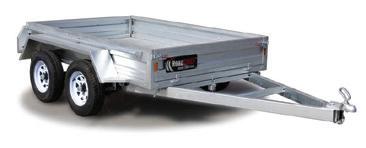





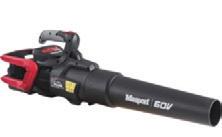


The Marlborough District Council was approached and released the following status of Sounds roads:-

The Anakiwa Road open to Tiri moana for residents only. Kenepuru Road, from the Moetapu Bay turnoff Moetapu Bay Road is closed for the length of the road.
Centre Valley Road is closed 520m from the start of the road, beyond the final residence. French Pass Road is open to res idents only from SH 6 through to Cissy Bay Turnoff. Closed about 3km before French Pass township.
Te Towaka – Port Ligar Road now open to residents only
NOW AT - 2 Warwick St, Mayfield, Blenheim 03 579 2500
• On Road • Off Road • Vineyard • Farm • Hedge • Lawn • Kea Trailers • Service • Parts • Finance 28 October 2022 Marlborough Farming TOP SOUTH MONTHLY
Wetland restoration event hosted by Wairau Valley Community Hub at Dayvinleigh. Photo: Supplied.
marlborough
One in four pastoral farmers threatened by ‘Waka Adrift’
TONY ORMAN
Marlborough Federated Farm ers is standing by its opposition to He Waka Eke Noa (HWEN) proposals around farm emissions relative to global warming and climate change.

HWEN mission statement says “working together with farmers and growers on practical solu tions to reduce Aotearoa’s emis sions and build resilience to cli mate change”. However, Marlborough Feder ated Farmers Meat and Wool chairman Richard Dawkins said there was growing dissatisfaction throughout the farming com munity with the proposals of
HWEN.
“Marlborough Federated Farm ers stands by by our opposing stance, a stance we have been leading for many months now,” he said.
“We believe any pricing mecha nism should recognise that New Zealand farmers are the most carbon-efficient in the world, be based on incentives not blanket taxes and recognise the fact that there are little if any mitigation options available for farmers, other than land use change re sulting in emissions leakage.”


The growing opposition was represented in recently-released open letter written by concerned sheep and beef farmers.
The letter says any hope that the He Waka Eke Noa recommen dations would deliver any value had been abandoned in the wake of widespread carbon farming by afforestation obliterating farms, community devastation and fur ther reduction of land remaining in pastoral use.
“The simple truth is that HWEN represents a faltering and resig nation to conflicted compromis es while departing from HWEN’s stated aims of enabling sustain able food and fibre production for future generations.
“Instead the current proposals are conservatively expected to drive one in four extensive, low environment impact sheep, beef
and deer farmers out of business and strangle the remainder, re sulting in massive community displacement and social upheav al, all the while He Waka Eke Noa proudly claims to be build ing farmer resilience to climate change.
“While our industry ‘leaders’ and government bask in political glory, in truth it will be approxi mately 6500 sheep, beef and deer farming families, their commu nities and schools and small pro vincial businesses who pay the price.”
Richard Dawkins says the narra tive around New Zealand farm ing needs to change.
“We are world leaders in grass-


fed, efficient protein production. The bulk of our emissions are methane which is a flow gas, not cumulative. Yes we can always improve, but industry needs to do a better job of educating the public around these facts”.
“The sad irony of the HWEN proposals will throw extensive sheep, beef and dairy farmers overboard to save other sectors from having to paddle harder,” said the open letter. “This is not an effective, fair or equitable way to achieve the Government’s emission reduction targets and shamelessly works against the goals of the National Policy Statements for both freshwater and biodiversity.”
Marlborough Feds roll up sleeves to help flood-hit farmers
TONY ORMAN
Marlborough Federated Farm ers monthly meeting focussed strongly on flood damage from recent rains. President Scott Ad ams said the Rai Valley in the Pelorus catchment was hit hard as was most of the Marlborough Sounds. On his own farm on the Northbank of the Wairau valley, damage has been less than last year’s July floods.
“It’s a lot more piecemeal,” he said. “There’s not the long lengths of fence lines to repair as back then in last year’s July.”
However for many farmers lower down valleys, it’s a normall busy time of the year with lambing and calving in full swing.
The floods although less for some this year, compared to July 2021, put pressure on farmers at one of
the busiest times of the year said Scott Adams.
Dairy section chairman and Evan White who farms in the Wairau Valley upstream of the Wye bridge said the recent flooding resulted in three floods in three days. At his farm 250 mm’s of rain fell over three days.


“We felt like drowned rats that was but a drop in the bucket compared to 1170mm at the top of the Opouri Valley in the up per Rai catchment. Milk collec tion was severely hampered and at one stage our farm was one of just nine farms out of 43 Fonterra was able to collect from. Bobbie calf pickups were halted also due to road closures to Nelson.”
Marlborough Federated Farmers with vice president Evan White and secretary Glenda Robb met most days with MPI, Rural Sup
port Trust. the Barge Company and Farmwise among others.
Then Marlborough Federated Farmers members Evan White, Neville Hall, Scott Adams, Glen da and Melva Robb from Rural Women NZ, Simon Tripe and Farmlands and FMG represen tatives travelled to the badly hit areas.
Neville Hall delivered potatoes and pumpkins while Rural Wom en NZ donated fruit cakes do nated by Rural Women up and down roads and to the Rai School talking with farmers about their concerns.
Reports indicate a dozen or more unit loads of hay or baleage were reported as delivered.



“The effects of this flood event will take months if not a year or more to fully recover from but they are a very resilient bunch
with a wonderful community spirit,” said Evan White.
President Scott Adams said farm ers were frustrated by the less ened ability of river management to cope with floods. He said bu reaucrats currently blamed the floods on climate change.
“The only worry the bureaucrats have around climate change is the temperature of the heat pump in their offices,” he said. “Farm ers are not in denial of climate change for climatic cycles are always happening. We know the climate is always changing, after all, we work in it every day,” he said.
However there was a need to re store past legislation governing the management and mainte nance of rivers and addressing soil conservation.
“The Soil Conservation and Riv







ers Control Act 1941, effective through the 1950s to 1980s, en abled farmers to get by even by the skin of their teeth. Back then, our previous generations worked hard to get vital river work done.” Then the Fourth Labour Govern ment in the 1980s implemented “reforms” disestablished catch ment boards and regional coun cils took over river management working under the Resource Management Act 1991.
“The RMA has not helped, the basic infrastructure has not been maintained and consequently rivers - and the community - has become extremely vulnerable. That could only last for so long and that long is now,” said Scott Adams. “It is well nigh time to bring back that effective 1941 leg islation and its associated river management.”
free to 14,500 rural
from Greymouth, Westport, Nelson /
Bay, Marlborough, Marlborough
20+ years of speaking directly to a target market



Farming TOP SOUTH MONTHLY SOUTH Farming NEW SEASON BEGINS WITH TOOLS! Ploughing Champs come to SeddonFarming NEW SEASON BEGINS WITHTHE RIGHTTOOLS!PRE-PRUNERS www.tobyrandall.co.nz Toby Randall “New vic TE interested entertained becoming Handling high pressure 100% locally owned and operated RAYLENE WADSWORTH raylene@waimeaweekly.co.nz Phone: 027 458 9115 • Based in the top of the South Island we are 100% locally owned and operated • With Barbara Stuart, editor with extensive on the ground knowledge and a growing team of journalists and relevant editorial content to support her. • Delivered
mailboxes every month,
Tasman, Golden
Sounds and everywhere in between •
for customers and readers alike. MarlboroughFarming TOP SOUTH MONTHLY October 2022 29
local forestryupdate
Forestry career a good decision
BARBARA STUART
As a young lad Nathan Taylor was given the opportunity to get in volved in the forestry industry. A decision he does not regret.
He says, it’s great to be part of the industry and associated with good people who are involved in it. Nathan’s passion for forestry comes from a very grounded per spective.
“Forestry provides a back bone to a lot of small heart land towns across New Zea land,” says the Tasman-based working director of Mech anised Cable Harvesting Limited.


tising
“There are a lot of people out there who rely on the income it provides across the wider forestry supply chain.”

The industry has come a long way toward improving over the past twenty years from men on the ground to highly skilled machinery operators, better health and safety stan dards and improved produc tion.

He predicts there will be more changes ahead for the industry due to industry transformation plans to ex port more finished products adding value to the raw logs.
Locally there is a lot of peo ple involved in the forestry industry either directly or indirectly servicing machin ery or through banking, ac countants and investment.
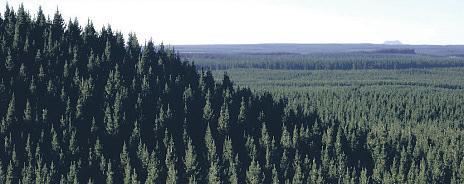

It is one of the four main export earners for the region along with fishing, fruit and farming that support our lo cal economy.
The recent storm event has left many in forestry unset
tled and uncertain. Add ing to a chain of things like Covid.
Nathan says it’s a labour market at the moment not a business focused time with things like the Matariki cele
bration and the Queens me morial day all adding cost to employers.
“It was nice to have a holi day, but business has to pay for it and hot on the heels of a storm event, supply chain issues and Covid which saw many unable to work in the Forestry sector its another cost to be met for business owners.”
What’s a real opportunity for the Nelson Tasman region is incentivising the removal of slash for biofuel mitigating bad environmental incidents like what happened in Tola ga Bay.
He says forestry gets a bad wrap but if you take a closer look there are twigs and de bris on our beaches that have come off the hills out of both native and pine forests but it’s not piles of logs.
As an industry we should be celebrating this not knock ing an industry that benefits so many given the volume of rain coming off the land.
Forest
25 years
the industry
Tasman Forest Management


D Stuart Forestry Ltd Independent Log Buyers Forest Managers Harvesting Marketing & Establishment Ph 03 542 3769 Mob 021 223 1099 stuartforestry@outlook.co.nz adver tisingpr oof Please check your proof carefully and approve it or submit corrections by the Final Proof Alterations deadline. now appro ve or submit changes to your ad within the ATOL system at a time that suits you. Just follow the link proof email to view your ad, then cl ick the APPROVE or CORRECTIONS button right from there no new emails required! The Professional
Management Company of Choice. PF Olsen is the leading provider of independent professional forestry services in New Zealand. Contact us now for all your forest management needs: • Harvest management and log marketing • Forest establishment and tending • Forest valuations • Due diligence on forest purchases/sales CH-8994297AA Nelson 03 544 0066 Blenheim 03 577 6675 OLSEN & CO LTD (RMD) publishing 06/24/21 booked size CSQ QUART VE CH-8994297AA (100%) publication Adv Supp NEM dimensions 12.3X12.4, cms width by height section CUSTOM SQUARE proofed 9/06/2021 12:22:08 PM adver
Please check your proof carefully and approve it or submit corrections by ve or submit changes to your ad within the ATOL system at a time that suits view your ad, then cl ick the APPROVE or CORRECTIONS button right from there The Professional Forest Management Company of Choice. PF Olsen is the leading provider of independent professional forestry services in New Zealand. Contact us now for all your forest management needs: • Harvest management and log marketing • Forest establishment and tending • Forest valuations • Due diligence on forest purchases/sales Nelson 03 544 0066 Blenheim 03 577 6675 LTD (RMD) publishing 06/24/21 booked (100%) publication Adv Supp NEM dimensions section CUSTOM SQUARE proofed The Professional Forest Management Company of choice PF Olsen is the leading provider of independent professional forestry services in New Zealand. Contact us now for all your forest management needs: • Carbon accounting and advice • Harvest management and log marketing • Forest establishment and tending • Forest valuations • Due diligence on forest purchases/sales With
experience in
the
(TFM) team offer services in: • Forest and woodlot harvesting • Domestic and Export Log Purchase • Forest Establishment • Emissions Trading Scheme advise and management • Forest Valuation • TFM are part of the Forest Management Group with offices throughout the South Island, Hawkes Bay and Southern North Island To find out more www.forestmanagement.co.nz Email: office@tasmanforest.co.nz Nelson 03 540 3177 Blenheim 03 572 7902 30 October 2022 Forestry Farming TOP SOUTH MONTHLY
Nathan Taylor of Cable Harvesting Ltd. (right) presenting the Skilled Professional of the YearAward to Grant Puk lowski at this years Top of the South Forestry Awards. Photo: Tim Cuff.
livestock
Will talk cows, til they come home
BARBARA STUART
Krystal Alsop-Coleman loves farming and she says, “I can talk about farming and cows till they come home.”
Krystal is only tiny but she is no slug when it comes to both topics. As a self employed contractor working on five farms in the Murchison area she has a roster to relief milk or help with any work on the five farms she supports.
Raised in Taylorville on the Westcoast, she attended Still water Primary School but says it was travelling around New Zealand in her parents house truck and doing her high school years by corre spondence that have helped to shape her life.
She planned to become an electrician and began poly tech in Christchurch but was driven out by the earthquakes and returned to Taylorville and more study while work ing part time.
She and her ex-partner ap
plied for a job on a Murchi son dairy farm and she says with a chuckle, one son and ten years later and now on her own she’s taken control of her work life.
Going from farm to farm observing how others do things has been a good way to learn
She has five farms she works for as a relief milker and any other jobs that need doing from calving to break feed ing. This keeps her busy, last year she had seven farms on her books but she says it was difficult to fit them all in on her roster.
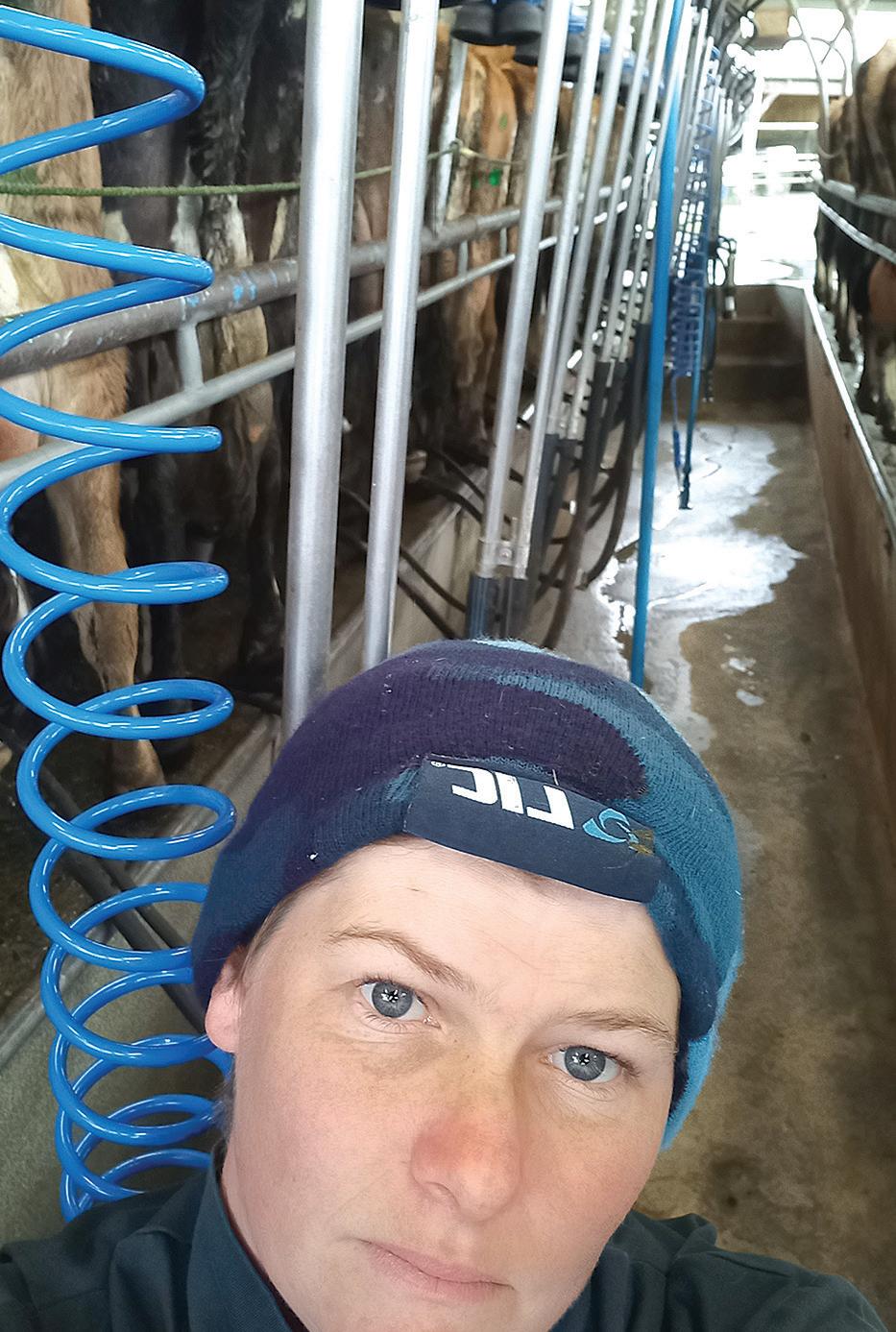
Her seven year old son Alex can tag long on the job if its child appropriate.
What Krystal enjoys most about her job is the variety, no two days are the same. Going from farm to farm she says
she is constantly learning.
Every farm in its own way is a source of knowledge. They all have their different reasons for how their systems work. When a cow isn’t doing well in a system rather than change the system to suit one cow its best not to persevere.

“Breeding from cows who suit the system and specific man agement style has been one of her key learnings.
“Knowledge is my friend, there is always a solution, go ing from farm to farm observ ing how others do things has been a good way to learn.”
Krystal says going forward climate is the biggest chal lenge facing farming. So far this season has gone from dry to wet and more wet and with calves landing on the ground its hard to work out what the weather will do next.
The extreme climate condi tions we are told will happen more are going to keep farm ing the land a real challenge.
Good quality wool attracts demand

With weather events wreaking havoc across many parts of New Zealand during the past sev eral weeks, wool quality could well suffer into the latter part of 2022, however currently there are some extremely well grown wool types being received into broker wool stores around the South Island.
On the coarse wool front, sev eral exceptionally good lines of pre-lamb fleece have been noted by brokers and exporters, with obvious premium prices being paid either through the auction system or via forward contracts agreed earlier.
Now that the fine wool season is well underway throughout
Marlborough, Canterbury and Otago, many lines of fleece sampled thus far have also proved extremely attractive for style, staple length and tensile strength and, with significant percentages of those types al ready forward contracted, all parties should be pleased with the quality of their deliveries. The wool auction arena has re cently witnessed lesser than an ticipated bale volumes coming forward in both the North and South Islands.
The most recent Napier auction at time of writing (25th Au gust), saw approximately 6700 bales (1300 fewer than original ly scheduled) of predominantly new season’s second shear of fered to the export trade, with around 18% failing to reach grower reserve prices despite a slightly softer NZD versus its US counterpart, although the
Kiwi had appreciated slightly against both the Euro and GBP, since the previous auction one week earlier. Although the mar ket in Napier could be quoted as “in buyers’ favour”, most inter est for second-shear types was targeted towards the better style wools of good washing colour and low vegetable matter con tamination.
Due to limited availability of poorer colour fleece types, giv en the time of year, the market for these improved by a few cents in the Napier auction room as a handful of exporters filled orders.
As earlier eluded, a feature of auction catalogues in the South Island throughout August were some magnificently grown full length coarse wool fleece lines, which commanded keen inter est from exporters, with several well-known farm brands, most
ly representing the Otago re gion, achieving healthy premi ums (between 75 and 90 cents clean in some instances) above others of similar length but with higher y minus z colour read ings.
During the past few weeks and despite snow and heavy rain causing issues for growers and transport operators in many high-country areas, Merino wool types have begun to flow into wool stores in Canterbury and Otago.
The first significant quantities of merino and finer halfbred types, were offered in the Christchurch auction of 18th August, greeted by exporters with sizeable order books to fill. Prices achieved for the fine merino types were quoted post-sale as “extreme” in many cases and above those ruling in Australian broker cat alogues the same week.
Finer halfbred types also sold well in Christchurch, although in comparison appeared cheap er than those quoted by Austra lian brokers the same week. At time of writing, South Island broker catalogues were being collated for the September 1st auction when larger bale num bers of similar types would be on offer and expectation was considerably optimistic. But back to the recent seri ous weather event and think ing about the probable many tonnes of synthetic flooring which will end up in landfill, and from a selfish wool perspec tive, wouldn’t it be great to have insurers of recently flood dam aged properties specify woolen floor coverings, manufactured at the very least in New Zealand or Australia, as healthy and sus tainable replacements?
That’s my view.
LivestockFarming TOP SOUTH MONTHLY October 2022 31
Krystal Alsop-Coleman at work with the cows.
Photo: Supplied.
fertilizer
Greener grass
JOHN BARNES Managing Director Fertilizer New Zealand


The business of growing pasture for our stock is becoming more com plicated as each year passes, but it needn’t be so. It is just that some people within the industry have been advising farmers about their particular product and its addition al benefits for pasture production.

Let us get back to the basics. Pasture is grown in soil. We all know that but where the differ ence becomes apparent is how we produce the pasture. In my mind there are two options and both will produce a paddock of green grass. One is that we force the soil to grow the required pasture.
The thinking behind this is that there needs to be sufficient nitro gen or any other element to allow the plant to grow. Essentially soak the soil with fertiliser so that some of it will get near the root system. The surface area of the root takes up about two per cent of the soil so it is a bit of a hit and miss. In the case of nitrogen, a point which isn’t discussed in the sufficient theory is that good soil can produce its own nitrogen - often up to 200 kgs per year. A typical ryegrass and clover pasture system uses 200 kgs of ni trogen per year, so applying extra nitrogen may be wasted. It would be a great idea to take a soil test to measure the amount of nitrogen that each farm has before applying more.
The second option can be broken
down into two sub-sections re garding fertilising plants, pasture or crops, both of which require less fertiliser. One is through the soil using soil biology and the second is feeding the plant through the leaf. Let us take these one a time. Feeding the plant through the soil requires the right type of nutrient and the correct amount at the right time, using soil biology to transfer fertility from the soil into the plant.
There are many types of nitrogen, phosphates, potashes, and sulphur. Each work in a differ ent way and can deliver a different result. Some are acidic, others are pH neutral, and some can turn into other forms of the elements, due to what is currently in the soil. For example, acidic phosphate can turn into iron phosphate with in a few months, which in turn be comes unavailable to plants. This means it will be wasted.
The foliar feed method, which is the other option, works by applying a balanced amount of product onto the plant and then in turn it will go into the leaf. Unfortunately, we con tinue to think only in single element fertiliser products when we think foliar but plants require a balanced diet to stay healthy. Any single ele ment like nitrogen can lock up oth er nutrients and then the plant will not grow to its true potential. That is why Fertilizer New Zealand has products that are well balanced and known for their ability to pro duce healthy plants and pasture. For more information, please con tact us on 0800 337 869.
The fix for waterlogged soils
In the short-term waterlogged soils require sunshine and warmth. Nothing else will speed recovery, with more rain slowing the process.

Frosts are useful as they lift moisture from the soil and the bright sunny days that follow increase the amount lost via evaporation.
It defies logic to fly nitrogen onto soils too wet to ground spread. The issue is too much water and not enough air in the soil, and nitrogen does nothing to alleviate either.
Money is best spent on high en ergy and fibre supplement, top quality meadow or lucerne hay the best combination of both.
Rumens require long fibre to provide a mat to function effi ciently and hay is an excellent solution and made freely avail able animals will eat no more than required to maintain body temperature and weight.
The long-term fix is to increase soil pore space, the space be tween soil particles that allows water to percolate downwards. There must be somewhere for the water to go, and each in dividual situation is different however what can be influ enced is the top 25mm of the soil, the area in which pasture roots are concentrated.
During periods of prolonged wet weather animals will create a mess, it’s unavoidable. The
decision is whether to have a small mess over a large area by spreading animals out, or con tain it to a small area that can be sorted later. There’s no per fect answer and it’s important for those that object to animals on crop in wet weather under stand the constraints that farm ers work under.
Soil temperature is one of the drivers of spring growth with temperatures above 10°C in dicating the start of spring growth. Excessively wet soils often have temperatures of around 10°C however it is not until they dry out somewhat that temperatures will rise sig nificantly, and optimum spring growth will be obtained. Wet land is cold land.
After prolonged periods of wet weather soils may become an aerobic, beneficial soil life is largely lost and soil odour be comes increasingly sour.
Re-establishing conditions un der which pastures thrive can take months and much of the coming season’s growth lost if action is not taken. Recovery however can be remarkably rapid without the need to cul tivate.
Physical aeration to a depth of 25cm breaks up compacted soils and when combined with an application of CalciZest, a lime-based soil improver from Functional Fertiliser contain ing a wide range of soil friendly fungi and bacteria, steady re covery can be achieved.


The addition of soil friendly microbes kick starts the pro cess and with regular rain
fall and sympathetic grazing management pastures can be nursed back to health reducing the slow growth phase.
Even in the worst situations earthworms are likely to exist in sufficient numbers to pro vide benefits over the coming months. They do an excel lent job of creating channels through which water drains and air enters. By creating the environment that favours their activity all other beneficial soil dwellers proliferate, and the key is ongoing inputs of calcium in the form of lime, dolomite, and soft phosphate rock.
Where cultivation is the best option the application of Cal ciZest and extra lime will help with soil tilth, germination of seed will be more rapid as will growth during the establish ment phase.
The addition of clover seed may also be beneficial as clo ver dense pasture grows more strongly over summer when grasses naturally go to seed due to a combination of soil tem peratures above 20°C and lon ger sunlight hours.
Animals grow and fatten more quickly on a high clover diet as clover contains the calci um necessary for rapid bone growth. Clover is also more digestible, so animals can eat more in their naturally desig nated grazing time. Because clover fixes nitrogen reliance on synthetic nitrogen is reduced creating a situation that is genuinely carbon pos itive. For more information contact Peter on 0800 843 809.
Got something to buy, sell or promote? Contact us: sales@ nmf.co.nz
Farming MONTHLY 32 October 2022 Fertilizer Farming TOP SOUTH MONTHLY
horticulture
Maintaining growers’ social licence
NADINE TUNLEY HortNZ

August was an intense month for our industry.
Wet weather continued to affect vegetable production across the country, particularly the Nelson region which declared a State of Emergency until the end of Au gust. Fruit as well as vegetable growers were affected, with or chards turning into rivers.


Many of you will have also seen the media turn its attention to the Recognised Seasonal Employer (RSE) scheme, with a series of negative stories culminating in a feature on the TVNZ Sunday programme. We are focused on correcting this negative percep tion and working with the gov ernment to improve the scheme they administer and manage.
The government is under im
mense pressure because of the labour shortage across New Zea land and deepening social issues.




That is perhaps why on the one hand, the government is relaxing immigra tion settings and pub licly offering support for the RSE scheme, while on the other hand, the govern ment is reviewing the scheme and involving unions.
Growers are passionate people, proud of what they do to feed New Zealanders and the world nutritious, great tasting food. However, being able to grow – use land and water, and have access to a workforce – is increasingly seen as a privilege.
As an industry, we talk about maintaining social licence – that is, maintaining our ability to grow
by having the support of New Zealanders and the government to plant, pick, pack and promote.
If we were to lose our social li cence, growing in this country would become a lot more challenging than it ready is. So ciety’s requirements are ever changing as new generations come through and the atti tudes of older genera tions change in response to what they see happening in New Zea land and the world.
The saying, ‘Do unto others as you would have them do unto you’, is often referred to as the ‘Golden Rule’ and has consider able currency in today’s society.
While as an industry we can show that 98 percent of RSE growers are good employees, one bad em ployer is one too many, and not
just in today’s environment. One bad employer is one too many, full stop. As an industry, we must come together and make that known.
The significant majority of you do a good to excellent job within the RSE scheme. If you are concerned about how others may be per forming, let your product groups know and we will assist. Remem ber, the RSE programme is yours collectively to protect.
Government as decision maker
The RSE scheme is a government run scheme and the Immigration Minister is the decision maker.
As an industry, we will continue to engage with the government, to give growers as much certainty as possible and to ensure that the scheme continues to deliver for the nine different Pacific nations that are part of the scheme, keep
ing in mind that each nation’s needs are different.
I believe that as an industry, we need to be united and clearly ar ticulate what we need, as well as the behaviours we expect of em ployers in the scheme. To break up and become disjointed or start to finger point would do nothing to maintain our social licence. In deed, I believe not acting in uni son would be highly damaging to growers’ social licence.
I know that growers are under immense pressure and it is com ing from all quarters, least of all the weather. But I firmly believe we must stick together, continue to promote what’s great and im portant about our industry and deal firmly with those – no mat ter how small in number – that threaten our industry’s social li cence at a time when we need it the most.
Growers say new policy statement is a step in the right direction

RNZ
Growers are hailing the gov ernment’s new national policy statement for highly produc tive land as a good first step. Released last week, the new rules are aimed at ensuring highly productive land can be used for growing vegetables, fruit and other produce. Councils will now need to identify, map, and manage productive land to protect it from inappropriate use and development.
However, they can still make it available for urban housing if there is no alternative, or if certain tests are met.
Horticulture New Zealand chief executive Nadine Tun ley said with good planning,


New Zealand could have both housing and fresh fruit and vegetables.
“HortNZ has advocated for nearly a decade for govern ment policy that recognises the importance of our best soils and ensures that they are prioritised for what they are best for - producing healthy vegetables and fruit.”
Nadine says there was a lot of work still to be done as the policy would need to integrate with two other policies, the Spatial Planning Bill and the Natural and Built Environ ments Bill which are replacing the Resource Management Act.
Nadine says the new policy statement gave growers more certainty about the future.
“It will help provide clarity around where [they] can de velop land and how they can function on land they current ly have, because there are a lot of problems with that in the peri-urban areas.”
She says Horticulture New Zealand would help councils through the process of map ping the best productive land. “Councils are the best place to do this work, but I know the industry and growers will be keen to be heavily involved because at the end of the day, they understand the impor tance of balancing the growing of fruit and vegetables while providing housing as well.
“This is a great first step and we’re really happy to see where this goes going forward.”
HorticultureFarming TOP SOUTH MONTHLY October 2022 33
motoring
Country MOTORING
with Ken Strungnell
On our farm we run a training facility for 4WDs SUVs quads and LUVs among others. The LUVs are used by many coun cils and govt. depts. They travel to areas too inaccessible for Utes. Because of the small size of the LUV they cope with difficult ground conditions, too rugged, tight turning, or water logged. The LUVs with the wider off road tyre and tighter turning cir cle along with the ability to carry cargo or often up to fouir people to these steep inaccessible areas has been the vehicle of choice. I wanted to test the suitability of the Jimny to replace an LUV; I’ve challenged the Jimny on full pressure road tires to compete. Similar in size, Approach, Ramp over and Departure angles, the Jimny has 210mm of ground clearance, so is a good match and very similar in price to the 1000cc LUVs

Both types use a full ladder
chassis. The latest Jimny has a comprehensive suite of tech and safety aids, none of which the LUVs have. Six Airbags, with both camera and infra red detec tion, Lane Departure, Auto High Beam, Hill Descent, Hill hold, ABS ABD ESP and Braked Trac tion Control [BTC]. The LUVs

Extremely Confident Suzuki Sierra Jimny
have a rear diff lock.
It is the BTC aid that separates the two. Braking a spinning wheel transferring the drive to the opposite side front or rear or both it maximises grip and there fore movement.

I tried it against the LUVs which only out performed the Jimny in

deep mud. They were equal in slippery shingle up or downhill tracks. The Jimny with a simple downhill descent switch was easy in wet grass downhill. In water the Jimny will wade up to 400mm which matched the LUVs.
Side slopes are much more com
fortable in the Jimny though both types were equal in perfor mance at around 40 degree slope. With the LUVs requiring for govt depts. at least seatbelts low doors upper nets AND helmets, the Jimny’s easy access doors and seat belts made it quicker to get in and out of. With 1500cc 5 speed manual as tested, or auto [my preference] uphill the Jim ny needs more momentum, than the CVT auto gearbox LUVs. I believe the 4 speed proper hy draulic gearbox as in most Utes would see the Jimny equal again. The big benefit is being able to use to drive on and off the farm, in the heated and air conditioned comfort of the Jimny, that’s more economical on fuel, less mainte nance from the more powerful 75kW 130Nm 4 cylinder petrol motor.
While available at around $41,990 for a flat deck two seat conversion, the boxy four seat wagon starting at $30,990 JX or $32,990 Sierra Manuals, or the $35,990 Auto make sense, par ticularly if fitted with mud and snow tires.
34 October 2022 Motoring Farming TOP SOUTH MONTHLY
A couple of people I’ve shown the Jimny Sierra to have called it a toy. The others recognized the value and use it can be put to. They were right!
Farmers Notice Board
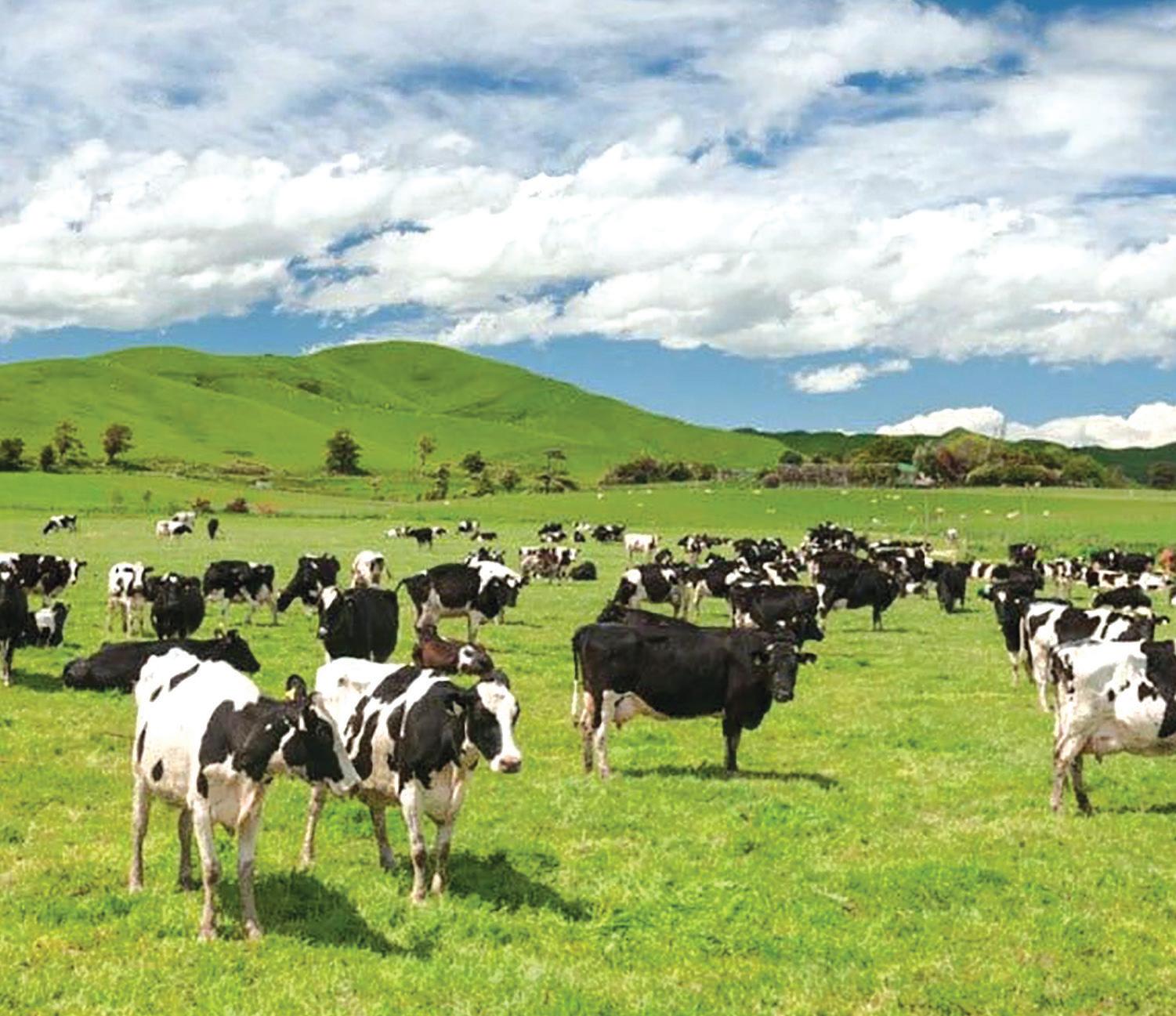











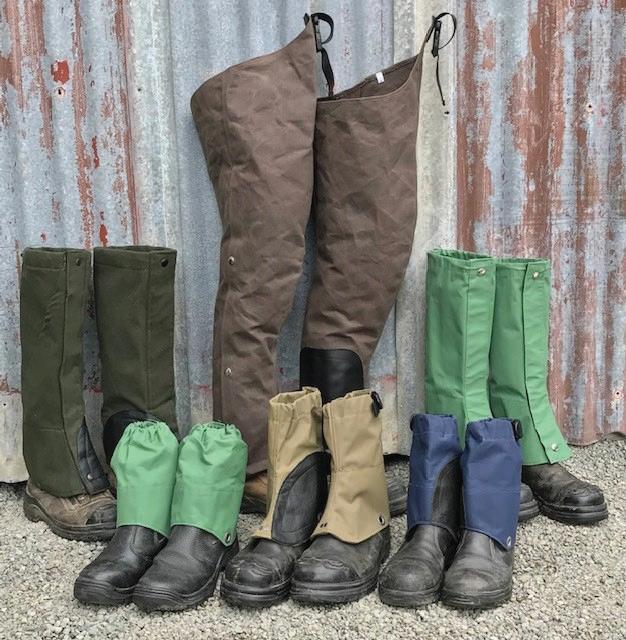









AVAILABLE NOW Give us a call on 03 577 9238 to find out more. Looking for storage? We have long and short term storage available for household item, boats, caravans, and trailers. Marlborough based. Export SEriES the indexed rotating clamping system 3 Angle adjustments • High Grade Stainless Steel • Hygienic • Easy Care • x2 clamps included, 1x Wide Clamp & 1x Narrow Clamp Visit scarysharp.co.nz for the full range talk to the manufacturer toll free 0800 175 720 The Constant Angle Knife Sharpening System The SIS Ball Cock Valve TARANAKI ENGINEERING SOLVING A NATION-WIDE FRUSTRATION WITH LEAKING BALLCOCKS So simple it could be serviced by your bank manager! Designed and manufactured in New Zealand We offer a lifetime warranty on the CNC machined main body 0800 175 720 www.sisballcock.co.nz We specialise in solutions for all budgets and needs. • Driveways • Patio’s & Paths • Decorative Concrete Cutting • Floor Placing & Finishing • Truck & Digger Services • Retaining Walls • Implement Sheds Call today for a free quote 541 8665 carterandsonsconcrete.co.nz Made in Canterbury New Zealand Puttees, Chaps, Radio Harness, Swag, Saddle Bags, and custom-made items www.mountainhighclothing.co.nz E: info@mountainhighclothing.co.nz P: 03 614 7731 NIKO TURIPA PH: 021 076 0388 E: niko@murchisonag.com MURCHISON REPAIRS & CONTRACTING AG • Servicing • General Engineering • 24 Hr Repairs & Maintenance • Farm Repairs • Welding / Grinding • Truck / Tractor Tyres • Effluent System Repairs • Heavy Equipment Repairs • Alloy & Stainless Work • Cow Shed & Yard Repairs • Machining LEWIS PASS / INANGAHUA / MURCHISON / LAKES www.stokegl.co.nz COMPOST PAVERS BARK SHINGLE GOATS WANTED DION BURGESS 022 199 7069 ALL BREEDS MALES / FEMALES / WETHERS FERAL GOATS DAIRY GOATS MEAT BREEDS ANY NUMBERS PROMPT PICK UP WILL BE ARRANGED SOUTH ISLAND ONLY dion@webuyanygoat.co.nz www.webuyanygoat.co.nz NoticeboardFarming TOP SOUTH MONTHLY October 2022 35
Got something to buy, sell or promote? Contact us: sales@nmf.co.nz Farming TOP SOUTH MONTHLY























Rod Payne Dave Filer FILCO KAWASAKI SOLUTIONS Powerful 850cc, 4WD, larger tip deck, high profile suspension. HERE NOW! STOCKMAN $6,343 plus gst LOTS OF FARM BIKE HERE AVAILABLE NOW!AVAILABLE NOW! • We come to you • Factory trained mechanics • Fully equipped mobile workshop • Spare parts on board • 4WD vehicle with workshop for easy access onto your farm • We understand the importance of efficiency • A regularly serviced farm machine last longer, performs flawlessly, is reliable and works hard for you • Happy to service all makes and models • Please book so we can best anticipate spares requirements and times • Easy to contact us on 03 547 2420 • We are good at what we do, we are friendly and we love working for our rural customers KLE 650 VERSYS KLX 300 $13,595 ride away $9,300$13,595$9,995 ride awayride awayride away MULE PRO MX 700cc 2 seater KLR 650 ADVENTURE KLE 300 VERSYS IF YOU NEED TO UPGRADE YOUR YAMAHA WORKHORSE IT IS VITAL YOU BACK ORDER NOW FARM, KIDS, MOTOX, ROAD, ADVENTURE AG125 PW50Wolverine X2 Ute YFZ50/YFM90 Filco, keeping our farmers farming BEAT THE PRICE RISE! LIMITED OFFER TTR50 $2,699 incl From $2,399 incl $3,299 incl From IN STOCK Layby for Christmas BEAT THE PRICE RISE! 36 October 2022 Advert Farming TOP SOUTH MONTHLY

 Nelson Marlborough Fish & Game
Nelson Marlborough Fish & Game




























































































































































































































































































